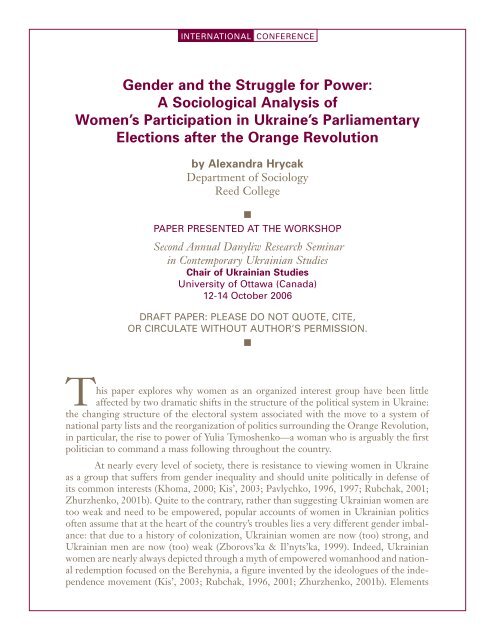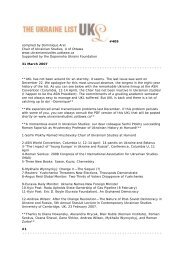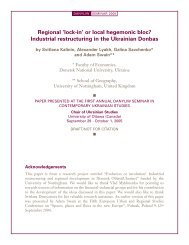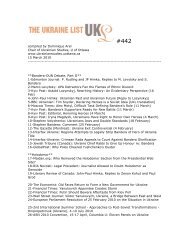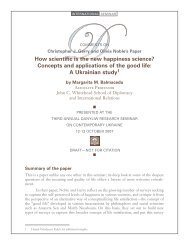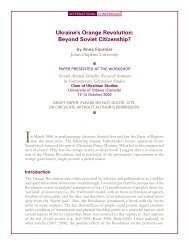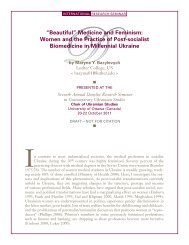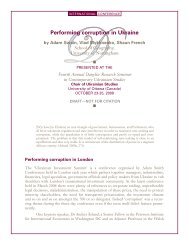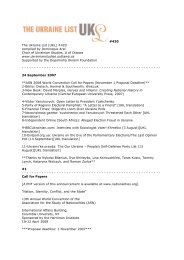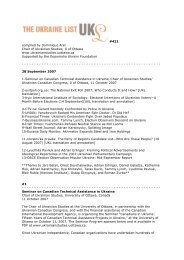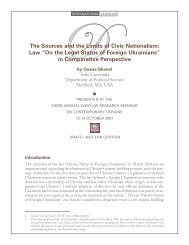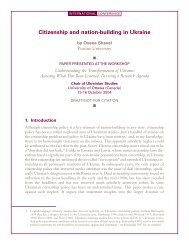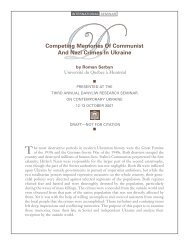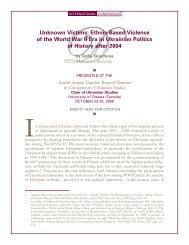Gender and the Struggle for Power: A Sociological - Chair of ...
Gender and the Struggle for Power: A Sociological - Chair of ...
Gender and the Struggle for Power: A Sociological - Chair of ...
Create successful ePaper yourself
Turn your PDF publications into a flip-book with our unique Google optimized e-Paper software.
international CONFERENCE<br />
<strong>Gender</strong> <strong>and</strong> <strong>the</strong> <strong>Struggle</strong> <strong>for</strong> <strong>Power</strong>:<br />
A <strong>Sociological</strong> Analysis <strong>of</strong><br />
Women’s Participation in Ukraine’s Parliamentary<br />
Elections after <strong>the</strong> Orange Revolution<br />
by Alex<strong>and</strong>ra Hrycak<br />
Department <strong>of</strong> Sociology<br />
Reed College<br />
■<br />
Paper presented at <strong>the</strong> Workshop<br />
Second Annual Danyliw Research Seminar<br />
in Contemporary Ukrainian Studies<br />
<strong>Chair</strong> <strong>of</strong> Ukrainian Studies<br />
University <strong>of</strong> Ottawa (Canada)<br />
12-14 October 2006<br />
Draft paper: please do not quote, cite,<br />
or circulate without author’s permission.<br />
■<br />
This paper explores why women as an organized interest group have been little<br />
affected by two dramatic shifts in <strong>the</strong> structure <strong>of</strong> <strong>the</strong> political system in Ukraine:<br />
<strong>the</strong> changing structure <strong>of</strong> <strong>the</strong> electoral system associated with <strong>the</strong> move to a system <strong>of</strong><br />
national party lists <strong>and</strong> <strong>the</strong> reorganization <strong>of</strong> politics surrounding <strong>the</strong> Orange Revolution,<br />
in particular, <strong>the</strong> rise to power <strong>of</strong> Yulia Tymoshenko—a woman who is arguably <strong>the</strong> first<br />
politician to comm<strong>and</strong> a mass following throughout <strong>the</strong> country.<br />
At nearly every level <strong>of</strong> society, <strong>the</strong>re is resistance to viewing women in Ukraine<br />
as a group that suffers from gender inequality <strong>and</strong> should unite politically in defense <strong>of</strong><br />
its common interests (Khoma, 2000; Kis’, 2003; Pavlychko, 1996, 1997; Rubchak, 2001;<br />
Zhurzhenko, 2001b). Quite to <strong>the</strong> contrary, ra<strong>the</strong>r than suggesting Ukrainian women are<br />
too weak <strong>and</strong> need to be empowered, popular accounts <strong>of</strong> women in Ukrainian politics<br />
<strong>of</strong>ten assume that at <strong>the</strong> heart <strong>of</strong> <strong>the</strong> country’s troubles lies a very different gender imbalance:<br />
that due to a history <strong>of</strong> colonization, Ukrainian women are now (too) strong, <strong>and</strong><br />
Ukrainian men are now (too) weak (Zborovs’ka & Il’nyts’ka, 1999). Indeed, Ukrainian<br />
women are nearly always depicted through a myth <strong>of</strong> empowered womanhood <strong>and</strong> national<br />
redemption focused on <strong>the</strong> Berehynia, a figure invented by <strong>the</strong> ideologues <strong>of</strong> <strong>the</strong> independence<br />
movement (Kis’, 2003; Rubchak, 1996, 2001; Zhurzhenko, 2001b). Elements
international CONFERENCE<br />
<strong>of</strong> this narrative are <strong>of</strong>ten present in discussions <strong>of</strong> a h<strong>and</strong>ful <strong>of</strong> “empowered” women<br />
such as Yulia Tymoshenko who have entered <strong>the</strong> (male) domain <strong>of</strong> politics. Through<br />
this myth, Tymoshenko’s rise to power is rendered as follows: a young Ukrainian women<br />
who is talented <strong>and</strong> energetic (not to mention beautiful) is born into relative poverty <strong>and</strong><br />
obscurity, achieves questionable wealth within <strong>the</strong> murky world <strong>of</strong> business (winning<br />
her <strong>the</strong> title “Petroleum princess”), <strong>and</strong> <strong>the</strong>n redeems herself by becoming nationally<br />
conscious <strong>and</strong> fighting as <strong>the</strong> “goddess <strong>of</strong> <strong>the</strong> revolution” <strong>and</strong> “mo<strong>the</strong>r <strong>of</strong> her nation” to<br />
bring Victor Yushchenko to power (Rubchak, 2005, 2006). Fur<strong>the</strong>rmore, <strong>the</strong> series <strong>of</strong><br />
fiascos that followed <strong>the</strong> Orange Revolution is retold as a story <strong>of</strong> epic gender imbalance,<br />
<strong>of</strong> a Ukrainian woman who is once again too strong (Tymoshenko) <strong>and</strong> a Ukrainian man<br />
who exhibits <strong>the</strong> pathological weaknesses found in all (male) Ukrainian politicians.<br />
This paper goes beyond <strong>the</strong> myths <strong>and</strong> cults regarding empowered Ukrainian<br />
women to explore <strong>the</strong> marginal role <strong>the</strong>y in reality play as political actors. It explores<br />
why <strong>the</strong> Orange Revolution <strong>and</strong> <strong>the</strong> move to a system <strong>of</strong> national party lists found<br />
women unprepared to mobilize on behalf <strong>of</strong> <strong>the</strong>ir own interests as a group. Below in<br />
section one, I first review social scientific studies that put <strong>for</strong>th a set <strong>of</strong> causal factors to<br />
account <strong>for</strong> variations in <strong>the</strong> level <strong>of</strong> female representation in post-socialist legislatures,<br />
<strong>and</strong> <strong>the</strong>n explain how studies <strong>of</strong> gender contribute to recent scholarship on post-Soviet<br />
democratization. I next explore in section two why women entered <strong>the</strong> political system<br />
in post-Soviet Ukraine in a marginal position. I demonstrate that during <strong>the</strong> <strong>for</strong>mative<br />
period <strong>of</strong> <strong>the</strong> late eighties <strong>and</strong> early nineties, women were at a structural <strong>and</strong> ideological<br />
disadvantage within <strong>the</strong> workplace as well as within <strong>the</strong> parties <strong>and</strong> organizations that<br />
emerged from <strong>the</strong> Soviet political establishment <strong>and</strong> <strong>the</strong> independence movement. In<br />
sections three <strong>and</strong> four I analyze <strong>the</strong> consequences <strong>the</strong>ir weak position in <strong>the</strong>se three<br />
sites has had in <strong>the</strong> period <strong>of</strong> political opportunity surrounding <strong>the</strong> Orange Revolution.<br />
Section three examines policies <strong>and</strong> legislation within <strong>the</strong> context <strong>of</strong> <strong>the</strong> women’s movement.<br />
Section four examines <strong>the</strong> parliamentary elections <strong>of</strong> 2006.<br />
I. GENDER AND DEMOCRATIZATION<br />
<strong>Gender</strong> <strong>and</strong> political influence in post-socialist parliaments<br />
There is widespread agreement among social scientists that women have been marginalized<br />
within post-Soviet politics <strong>and</strong> more broadly, that throughout Central <strong>and</strong> Eastern<br />
Europe, women found <strong>the</strong>mselves pushed out <strong>of</strong> public life after <strong>the</strong> fall <strong>of</strong> communism<br />
(Gal & Kligman, 2000a, 2000b). Studies have identified several main sets <strong>of</strong> constraints<br />
that have hindered <strong>the</strong> development <strong>of</strong> greater political power among women in postsocialist<br />
countries. These include <strong>the</strong> end <strong>of</strong> gender quotas, a resurgence <strong>of</strong> neotraditional<br />
attitudes regarding gender roles, <strong>the</strong> weakness <strong>of</strong> local feminist movements,<br />
2
international CONFERENCE<br />
<strong>the</strong> tendency <strong>for</strong> women in post-socialist societies to subordinate <strong>the</strong>ir potential group<br />
interests to o<strong>the</strong>r issues, <strong>and</strong> widespread gender discrimination in <strong>the</strong> labor market that<br />
results in economic insecurity <strong>and</strong> resource problems (Matl<strong>and</strong> & Montgomery, 2003;<br />
Saxonberg, 2000).<br />
Women fared poorly in nearly all post-communist countries in <strong>the</strong> first elections<br />
following <strong>the</strong> demise <strong>of</strong> gender quotas. However, significant differences have emerged<br />
subsequently in <strong>the</strong>ir ability to enter <strong>and</strong> influence post-communist political systems.<br />
These differences have resulted in considerable variation across countries in <strong>the</strong> gender<br />
composition <strong>of</strong> subsequent post-socialist legislatures. Political scientists who have<br />
examined <strong>the</strong>se variations at first wondered if <strong>the</strong>y could be attributed to <strong>the</strong> structure<br />
<strong>of</strong> electoral systems. Theories drawn from Western European cases suggest that women<br />
do better in proportional representation (PR) systems than in ei<strong>the</strong>r single member territorial<br />
district elections or mixed systems that include elements <strong>of</strong> both (Matl<strong>and</strong> &<br />
Montgomery, 2003; Saxonberg, 2000). This is because in PR systems, parties are more<br />
likely to include women to balance party lists than <strong>the</strong>y are to run women c<strong>and</strong>idates<br />
in a single district. Yet PR helps account <strong>for</strong> some but not all cases in which <strong>the</strong>re has<br />
been considerable growth in women’s representation since <strong>the</strong> collapse <strong>of</strong> communism.<br />
According to <strong>the</strong> largest comparative study, “countries with substantial representation<br />
<strong>of</strong> women where <strong>the</strong>re has been a marked increase in representation since <strong>the</strong> first<br />
post-communist election [share] a number <strong>of</strong> traits in common…party list PR systems”,<br />
combined with “<strong>the</strong> desire to ‘join’ Western Europe” <strong>and</strong> high levels <strong>of</strong> mobilization <strong>of</strong><br />
women both inside <strong>and</strong> outside political parties (Matl<strong>and</strong>, 2003, pp. 322-323)<br />
What happens when PR is introduced yet <strong>the</strong> electorate <strong>and</strong> leadership <strong>of</strong> a country<br />
remain divided about joining Europe <strong>and</strong> women experience low levels <strong>of</strong> mobilization<br />
in civil society <strong>and</strong> are not a <strong>for</strong>ce within political parties? Ukraine since <strong>the</strong> Orange<br />
Revolution presents an intriguing case <strong>for</strong> exploring <strong>the</strong> impact on women’s political<br />
influence <strong>of</strong> a shift toward a PR system in combination with a partial (<strong>and</strong> highly contested)<br />
turn toward Europe <strong>and</strong> relatively weak women’s mobilization inside <strong>and</strong> outside<br />
political parties. In <strong>the</strong> first two elections since <strong>the</strong> opening up <strong>of</strong> <strong>the</strong> electoral process<br />
to competition in 1990, <strong>the</strong> country adopted a “majoritarian” single member territorial<br />
district system. In 1998, it switched to a mixed system in which half <strong>the</strong> seats were<br />
decided through single member territorial district elections <strong>and</strong> half through national<br />
party lists. It <strong>the</strong>n switched in its fifth parliamentary election in 2006 to its current<br />
pure PR electoral system. Throughout this period, <strong>the</strong> percentage <strong>of</strong> female legislators<br />
elected in Ukraine has fluctuated, while lagging well behind nearly all o<strong>the</strong>r post-socialist<br />
countries in Eastern Europe. 1 Women were elected in 1990 to 3 percent <strong>of</strong> <strong>the</strong> seats in<br />
1. According to <strong>the</strong> Inter-Parliamentary Union, <strong>the</strong> percentage <strong>of</strong> women in national legislatures in Eastern<br />
Europe is at present: Belarus 29.1% lower house <strong>and</strong> 31.0% upper house (2004), Bulgaria 22.1%<br />
(2005), Lithuania 22.0% (2004), Republic <strong>of</strong> Moldova 21.8% (2005), Croatia 21.7% (2003), Latvia<br />
21% (2002), Pol<strong>and</strong> 20.4% lower house <strong>and</strong> 13.0% upper house (2005), Estonia (2003) 18.8%, Bosnia<br />
<strong>and</strong> Herzegovina 16.7% lower house <strong>and</strong> 0.0% upper house (2002), Slovakia 16.0% (2006), Czech Re-<br />
3
international CONFERENCE<br />
Ukraine’s Rada. In 1994, <strong>the</strong>ir share <strong>of</strong> seats increased to 5 percent. Under <strong>the</strong> mixed<br />
system in place in 1998, <strong>the</strong> overall proportion <strong>of</strong> women elected increased to 8 percent,<br />
with women somewhat more likely to be elected through party lists under PR than in<br />
single member territorial districts. 2 It <strong>the</strong>n dropped again in 2002 to 5 percent (bringing<br />
Ukraine <strong>the</strong> distinction <strong>of</strong> being in last place in Central <strong>and</strong> Eastern Europe in terms <strong>of</strong><br />
women’s representation). In 2006 after <strong>the</strong> Orange Revolution, it rose to its current level<br />
<strong>of</strong> 8.7 percent. Thus today <strong>the</strong> gender gap in Ukraine is only slightly smaller than it was<br />
under <strong>the</strong> mixed system that existed be<strong>for</strong>e <strong>the</strong> move to pure PR.<br />
In countries like Ukraine (as well as Russia), women have experienced difficulty<br />
gaining political power <strong>and</strong> <strong>the</strong>re has not been a strong upward trend in <strong>the</strong>ir representation<br />
in politics since <strong>the</strong> collapse <strong>of</strong> communism. We would expect women’s parliamentary<br />
representation to increase in such cases following a move from a mixed system to<br />
pure PR, in particular if such a shift occurs alongside a substantial reorientation <strong>of</strong> <strong>the</strong><br />
country’s leadership toward Europe <strong>and</strong> widespread mobilization <strong>of</strong> women into politics<br />
<strong>and</strong> public life. But <strong>the</strong> “turn toward Europe” <strong>and</strong> <strong>the</strong> rise <strong>of</strong> a strong women’s movement<br />
have not yet taken place. It is never<strong>the</strong>less important to explore such cases to provide<br />
<strong>the</strong>oretical insight into <strong>the</strong> moderating effect that ambivalence toward Europe <strong>and</strong> a<br />
weak women’s movement have on <strong>the</strong> impact <strong>of</strong> a move to PR.<br />
Theoretical contributions <strong>and</strong> concerns<br />
My analysis <strong>of</strong> <strong>the</strong> persistence <strong>of</strong> <strong>the</strong> gender gap in Ukrainian politics contributes to perspectives<br />
on democratization that are concerned with underst<strong>and</strong>ing <strong>the</strong> enduring mechanisms<br />
<strong>of</strong> social control that prevent groups <strong>of</strong> citizens in post-Soviet states from making<br />
better use <strong>of</strong> <strong>for</strong>mal mechanisms <strong>of</strong> democracy. Much scholarship in recent years has<br />
sought to explain <strong>the</strong> perverse dynamics <strong>of</strong> political power in post-Soviet countries that<br />
have not developed stable democratic systems (Wilson, 2005). To indicate <strong>the</strong> mixed <strong>and</strong><br />
contradictory outcomes <strong>of</strong> democratization in Ukraine, scholars have proposed categorizing<br />
<strong>the</strong> new political system as “competitive authoritarianism” (Way, 2004), “delegative<br />
democracy” (Kubicek, 2001), or simply, “<strong>the</strong> blackmail state” (Darden, 2001). At <strong>the</strong> heart<br />
<strong>of</strong> <strong>the</strong>se analyses lies a simple assumption: that elite gatekeepers impede <strong>the</strong> consolidation<br />
<strong>and</strong> institutionalization <strong>of</strong> democracy by exploiting <strong>the</strong>ir control over resources. Great<br />
attention has been paid in this literature to in<strong>for</strong>mal mechanisms <strong>of</strong> control, in particular,<br />
public 15.5% lower house <strong>and</strong> 12.3% upper house (2006), Montenegro 12.5% (2002), Slovenia 12.2%<br />
lower house <strong>and</strong> 7.5 upper house (2004), Serbia 12.0% (2003), Romania 11.2% lower house <strong>and</strong> 9.5<br />
upper house (2004), Hungary10.4% (2006), <strong>the</strong> Russian Federation 9.8% lower house <strong>and</strong> 3.4 upper<br />
house (2003) <strong>and</strong> Albania 7.1% (2005). See http://www.ipu.org/wmn-e/classif.htm.<br />
2. Researchers have debated how <strong>the</strong> move to a mixed PR system affected <strong>the</strong> gender gap in Ukraine.<br />
Andreenkova (2002) argues that women in Ukraine’s 1998 parliamentary elections were no more likely<br />
to be elected in PR than in majoritarian districts. However, Birch (2003) contends that <strong>the</strong>y were more<br />
likely to be elected through party lists.<br />
4
international CONFERENCE<br />
to <strong>the</strong> use <strong>of</strong> “administrative resources” to rig <strong>the</strong> electoral system so as to win control <strong>of</strong><br />
parliament <strong>and</strong> impose various substantive <strong>and</strong> procedural preferences on o<strong>the</strong>r political<br />
actors (Allina-Pisano, 2005). But as <strong>the</strong> outcomes <strong>of</strong> both <strong>the</strong> Orange Revolution <strong>and</strong> <strong>the</strong><br />
“clean” parliamentary elections <strong>of</strong> 2006 show, control over parliament <strong>and</strong> its procedures<br />
can also be achieved through o<strong>the</strong>r means than employment <strong>of</strong> administrative resources<br />
to rig elections.<br />
The literature on post-communist gender <strong>and</strong> politics helps us see how we can<br />
go beyond a focus on resources—in particular, “administrative resources”— to account<br />
<strong>for</strong> <strong>and</strong> underst<strong>and</strong> <strong>the</strong> broader structural <strong>and</strong> institutional reasons why power imbalances<br />
remain after <strong>the</strong> Orange Revolution <strong>and</strong> <strong>the</strong> advent <strong>of</strong> “cleaner” national elections.<br />
Analyses <strong>of</strong> <strong>the</strong> mobilization <strong>of</strong> women enrich our underst<strong>and</strong>ing <strong>of</strong> <strong>the</strong> complex role<br />
anti-Western ideological templates still play in shoring up <strong>the</strong> power structure <strong>and</strong> preventing<br />
<strong>the</strong> development <strong>of</strong> stable democratic institutions. Patriarchal notions <strong>of</strong> what<br />
political leaders <strong>and</strong> citizens should “look <strong>and</strong> act like” undergird <strong>the</strong> endemic material<br />
dependencies <strong>and</strong> relationships <strong>of</strong> patronage that cripple, coopt or subvert grassroots<br />
challenges to corruption in Ukraine. 3 As <strong>the</strong> studies <strong>of</strong> gender <strong>and</strong> proportional representation<br />
reviewed above suggest, embracing pro-European values <strong>and</strong> adopting models <strong>of</strong><br />
gender equality are an important precondition not only <strong>for</strong> <strong>the</strong> empowerment <strong>of</strong> women<br />
as civic <strong>and</strong> political actors. They also aid <strong>the</strong> institutionalization <strong>of</strong> a set <strong>of</strong> norms <strong>and</strong><br />
values that are supportive <strong>of</strong> <strong>for</strong>mal democratic political institutions.<br />
Most scholarship on post-Soviet politics has tended not to incorporate gender<br />
issues systematically into discussions <strong>of</strong> <strong>the</strong> in<strong>for</strong>mal practices <strong>of</strong> social control that<br />
undermine <strong>the</strong> fragile foundations <strong>of</strong> democratization. Indeed, gender has generally<br />
been overlooked in studies <strong>of</strong> post-Soviet democratization. <strong>Gender</strong> was at first overlooked<br />
because it was not considered as a potential primary electoral cleavage akin to<br />
region, ethnicity or language. 4 <strong>Gender</strong> was later overlooked became it became associated<br />
mainly with Western aid <strong>and</strong> “nonpolitical” projects to build civil society. 5 But a focus<br />
on gender provides a revealing lens through which to gain a better underst<strong>and</strong>ing <strong>of</strong> <strong>the</strong><br />
manner in which state socialist legacies <strong>of</strong> domination (in particular, patriarchal control<br />
over resources <strong>and</strong> appointments by gatekeepers) undermine new electoral structures <strong>and</strong><br />
3. Organized groups <strong>of</strong> citizen have emerged. They have begun to articulate <strong>the</strong>ir dem<strong>and</strong>s <strong>and</strong> have even<br />
been able to engage in effective acts <strong>of</strong> protest, most visibly <strong>the</strong> Orange Revolution. But <strong>the</strong>y have thus<br />
far proven unable to use Western style advocacy techniques to achieve <strong>the</strong> changes <strong>the</strong>y have sought<br />
in <strong>the</strong>ir relationship to <strong>the</strong> state. For a discussion <strong>of</strong> <strong>the</strong> impact <strong>of</strong> Western advocacy techniques on<br />
women’s engagement in politics <strong>and</strong> public life, see Hrycak (2006; <strong>for</strong>thcoming 2007).<br />
4. There are now many exceptions. For one <strong>of</strong> <strong>the</strong> earliest studies to incorporate gender into an analysis<br />
<strong>of</strong> political support, see Hesli & Miller (1993).<br />
5. The assumption that Western aid to develop civil society was “non-political” has persisted among<br />
social scientists even though from <strong>the</strong> start, studies demonstrated that all <strong>for</strong>ms <strong>of</strong> Western aid were<br />
dominated by state elites <strong>and</strong> were being used to shore up <strong>the</strong>ir position <strong>of</strong> advantage (Henderson,<br />
2002; Hrycak, 2006; Wedel, 1998).<br />
5
international CONFERENCE<br />
new patterns <strong>of</strong> political participation <strong>and</strong> complicate ef<strong>for</strong>ts to implement new political<br />
models oriented toward Europe <strong>and</strong> <strong>the</strong> West.<br />
II. GENDER INEQUALITY:<br />
PRIOR TO THE ORANGE REVOLUTION<br />
Accounts <strong>of</strong> <strong>the</strong> Orange Revolution have sought to explain it using an argument that<br />
views this event as <strong>the</strong> expression <strong>of</strong> pent-up grievances regarding political corruption<br />
<strong>and</strong> malfeasance (Tucker, 2005). This assumes that <strong>the</strong>re is a direct or easy relationship<br />
between <strong>the</strong> appearance <strong>of</strong> protest movements <strong>and</strong> general increases in economic<br />
<strong>and</strong> political grievances. Such an approach falls into <strong>the</strong> trap <strong>of</strong> earlier social scientific<br />
research that assumed collective action was a more or less unmediated phenomenon in<br />
which atomized individuals spontaneously reacted to frustration once <strong>the</strong>ir emotions<br />
reached a certain threshold. Research on social movements has found little evidence to<br />
support deprivation-based explanations <strong>of</strong> protest (Jenkins, 1983; McAdam, Tarrow, &<br />
Tilly, 2001; McCarthy & Zald, 1977; Meyer & Imig, 1993; Meyer & Staggenborg, 1996;<br />
Tarrow, 1998). While most studies agree that moments <strong>of</strong> political realignment such as<br />
<strong>the</strong> Orange Revolution exp<strong>and</strong> opportunities <strong>for</strong> aggrieved groups to enter politics, <strong>the</strong>y<br />
find that a focus on grievances fails to explain which groups succeed <strong>and</strong> which groups<br />
fail to mobilize. To engage successfully in protest, <strong>the</strong>se studies indicate that challengers<br />
must have completed considerable advance work generating <strong>the</strong> basic elements <strong>of</strong> a social<br />
movement: articulating a common collective identity, building effective organizations<br />
<strong>and</strong> developing stable alliances to political allies <strong>and</strong> supportive groups.<br />
The following section explores obstacles that deterred women from accomplishing<br />
<strong>the</strong> work needed to develop into a social movement be<strong>for</strong>e <strong>the</strong> Orange Revolution.<br />
It analyzes in detail <strong>the</strong> mechanisms <strong>of</strong> gender domination that operated to marginalize<br />
women in <strong>the</strong> Soviet workplace, <strong>the</strong> Communist party system, <strong>the</strong> independence movement,<br />
<strong>and</strong> more broadly, within <strong>the</strong> political system that emerged during <strong>the</strong> first years<br />
<strong>of</strong> independence.<br />
<strong>Gender</strong> stratification in <strong>the</strong> workplace: A hidden Soviet legacy<br />
Officially, <strong>the</strong>re was no discrimination against women in <strong>the</strong> Soviet Union. Hidden <strong>for</strong>ms<br />
<strong>of</strong> discrimination were widespread, particularly in <strong>the</strong> workplace. Yet while women occupied<br />
a position <strong>of</strong> structural disadvantage, <strong>the</strong>ir grievances were obscured <strong>and</strong> hidden.<br />
State policies to promote employment <strong>of</strong> women <strong>and</strong> support <strong>the</strong> “working mo<strong>the</strong>r”<br />
made it difficult <strong>for</strong> women to be seen as a disadvantaged group. Lengthy maternity<br />
leaves <strong>and</strong> o<strong>the</strong>r measures intended to encourage childbearing <strong>and</strong> employment among<br />
women rein<strong>for</strong>ced perceptions that women were a privileged group that enjoyed an<br />
advantageous position under state socialism. This served to delegitimate women’s polit-<br />
6
international CONFERENCE<br />
ical activity under postcommunism (Gal & Kligman, 2000a).<br />
A heavy burden <strong>of</strong> maternal duties reduced <strong>the</strong> time <strong>and</strong> energy women could<br />
devote to advancing <strong>the</strong>ir careers <strong>and</strong> br<strong>and</strong>ed <strong>the</strong>m unreliable workers. It was considerably<br />
more difficult <strong>for</strong> women than men to be promoted up levels <strong>of</strong> authority in <strong>the</strong><br />
workplace <strong>and</strong> in <strong>the</strong> party. Indeed, outside intellectual circles, to refer to a woman as<br />
“pursuing a career” was to imply that she had loose morals <strong>and</strong> was sleeping with her boss<br />
to get favorable treatment. <strong>Power</strong>ful organizational positions in Soviet workplaces were<br />
almost entirely dominated by men. Even though, generally, women in Soviet Ukraine<br />
were better educated than men, <strong>the</strong>y were rarely found in decision-making positions<br />
(Pavlychko, 1992). Women were crowded into dead-end jobs where <strong>the</strong>y per<strong>for</strong>med what<br />
was considered “women’s work.” Many women were employed within low wage economic<br />
sectors such as food <strong>and</strong> textile processing, childcare, <strong>and</strong> agriculture. Pr<strong>of</strong>essional<br />
women also faced gender discrimination. Like o<strong>the</strong>r women workers, <strong>the</strong>y tended to<br />
work in “feminized” jobs within education, health care <strong>and</strong> o<strong>the</strong>r pr<strong>of</strong>essions where most<br />
employees were women <strong>and</strong> most managers were men.<br />
The transition from state socialism should have deconcentrated control over<br />
basic resources <strong>and</strong> increased opportunities <strong>for</strong> challenging or exiting this system <strong>of</strong><br />
gender domination. But in <strong>the</strong> short run <strong>the</strong> transition instead increased <strong>the</strong> impact <strong>of</strong><br />
<strong>the</strong>se longst<strong>and</strong>ing gender inequalities. Women have been hit far harder than men with<br />
unemployment <strong>and</strong> a host <strong>of</strong> problems associated with privatization (Zhurzhenko, 1999,<br />
2001a). On average women receive roughly twenty-five to <strong>for</strong>ty percent less pay (Hrycak,<br />
2001). The closure <strong>of</strong> manufacturing plants, daycare centers, scientific research units<br />
<strong>and</strong> many o<strong>the</strong>r organizations that employed a predominantly female labor<strong>for</strong>ce pushed<br />
women out <strong>of</strong> public-sector jobs into private or in<strong>for</strong>mal economic activity more quickly<br />
than men. As a result <strong>of</strong> <strong>the</strong> absence <strong>of</strong> economic opportunities <strong>for</strong> women workers in <strong>the</strong><br />
private sector (managers still consider women “mo<strong>the</strong>rs first” <strong>and</strong>, hence, “unreliable”<br />
workers), many more women than men have difficulty finding new jobs that pay adequately.<br />
Women who have a higher education are more likely than men who are equally<br />
qualified to work in petty trade <strong>and</strong> within this sector, to be engaged in less pr<strong>of</strong>itable<br />
<strong>and</strong> less secure activities (Williams & Balaz, 2002). Women entrepreneurs tend to operate<br />
smaller <strong>and</strong> less secure businesses <strong>and</strong> are rarely found among executives in medium<br />
or large businesses (United Nations Development Program, 2003). Women are also<br />
more likely to experience unemployment. The percentage <strong>of</strong> women among those who<br />
registered with <strong>the</strong> state reached a peak <strong>of</strong> over eighty percent in 1992. It later decreased<br />
slowly. In 1995, seventy-three percent <strong>of</strong> those registered as unemployed were women.<br />
Since 1998 <strong>the</strong> percentage <strong>of</strong> women among <strong>the</strong> unemployed has remained stable at<br />
around sixty-two percent (United Nations Development Program, 2003).<br />
In summary, gender segregation in <strong>the</strong> work<strong>for</strong>ce was an important if hidden legacy<br />
<strong>of</strong> <strong>the</strong> Soviet Union. Stereotypes rooted in traditional gender roles were rein<strong>for</strong>ced<br />
by state programs on behalf <strong>of</strong> “working mo<strong>the</strong>rs” <strong>and</strong> placed women at a significant<br />
structural disadvantage. Yet despite <strong>the</strong> actual pervasiveness <strong>of</strong> gender inequality under<br />
state socialism, its nature <strong>and</strong> extent remained obscured by widespread beliefs that social-<br />
7
international CONFERENCE<br />
ist states promoted women <strong>and</strong> <strong>the</strong>ir interests. Since <strong>the</strong> transition, strong associations<br />
to mo<strong>the</strong>rhood have been a significant liability <strong>for</strong> women in <strong>the</strong> work<strong>for</strong>ce. Women in<br />
Ukraine consequently experience greater economic insecurity than men. But in public<br />
life, <strong>the</strong>re is still little support <strong>for</strong> advocates who view women in Ukraine as a group that<br />
suffers from gender inequality <strong>and</strong> should unite politically in defense <strong>of</strong> its common<br />
interests (Khoma, 2000; Kis’, 2003; Pavlychko, 1996, 1997; Rubchak, 2001; Zhurzhenko,<br />
2001b).<br />
<strong>Gender</strong> <strong>and</strong> <strong>the</strong> political left: The Communist Party <strong>of</strong> Ukraine<br />
By channeling women <strong>and</strong> women’s issues into “feminized” organizational niches within<br />
<strong>the</strong> Communist party <strong>and</strong> its post-Soviet successors, Soviet legacies <strong>of</strong> gender segregation<br />
also restricted women’s ability to play an active role in politics in <strong>the</strong> post-Soviet era.<br />
Men who <strong>for</strong>med a closed elite dominated <strong>the</strong> Soviet political system. There were no<br />
women in <strong>the</strong> Politburo <strong>and</strong> in <strong>the</strong> inner circle <strong>of</strong> <strong>the</strong> Party leadership. Soviet Ukraine’s<br />
party elite also never accepted women. Party leaders prevented women as a group from<br />
developing political influence or raising gender inequality as a political issue (Pavlychko,<br />
1992, p. 83). Yet <strong>the</strong> promotion <strong>of</strong> token women within Party channels also contributed<br />
toward public perceptions that women were well represented in <strong>the</strong> political system <strong>and</strong><br />
that <strong>the</strong>ir primary problems had been solved by <strong>the</strong> Soviet state.<br />
In <strong>the</strong> post-war era, women entered <strong>the</strong> world <strong>of</strong> party politics in large numbers<br />
By <strong>the</strong> eighties, <strong>the</strong>y made up roughly a quarter <strong>of</strong> members <strong>of</strong> <strong>the</strong> Communist Party<br />
<strong>of</strong> Ukraine <strong>and</strong> 30% <strong>of</strong> <strong>the</strong> members <strong>of</strong> various elected party organizations <strong>and</strong> boards<br />
(Hrycak, 2001). Quotas ensured that women held about one half <strong>of</strong> <strong>the</strong> seats in Ukraine’s<br />
local <strong>and</strong> oblast councils, <strong>and</strong> a third <strong>of</strong> <strong>the</strong> seats in <strong>the</strong> republic’s Verkhovna Rada, or<br />
parliament. Yet <strong>the</strong> vast majority <strong>of</strong> women who were members <strong>of</strong> <strong>the</strong> party remained<br />
crowded at <strong>the</strong> bottom <strong>of</strong> <strong>the</strong> political system. Party leaders typically assigned a few token<br />
women to positions that were secondary in importance <strong>and</strong> were un<strong>of</strong>ficially “reserved<br />
<strong>for</strong> women.” Usually this was <strong>the</strong> so-called “third”, or ideological, secretary in a local<br />
or regional party bureau. They also appointed women to ano<strong>the</strong>r secondary <strong>and</strong> usually<br />
female position in politics: that <strong>of</strong> <strong>the</strong> deputy chairman <strong>of</strong> a municipality. This <strong>of</strong>fice<br />
usually dealt with issues <strong>of</strong> culture <strong>and</strong> education. Women who occupied such positions<br />
were confined to minor <strong>of</strong>fices <strong>and</strong>, in fact, wielded little authority <strong>and</strong> experienced few<br />
opportunities <strong>for</strong> upward mobility.<br />
Women were also singled out as a group that was encouraged to mobilize during<br />
glasnost <strong>and</strong> perestroika. Party leader Mikhail Gorbachev acknowledged that Soviet<br />
policies had provided inadequate levels <strong>of</strong> support to women. He pledged to alleviate<br />
<strong>the</strong> stresses women faced in <strong>the</strong> workplace <strong>and</strong> at home. He also promised to promote<br />
more women to positions <strong>of</strong> authority. More importantly still, Gorbachev created an<br />
organizational channel <strong>for</strong> increasing women’s political access. In 1987, he revived <strong>of</strong>ficial<br />
organizations called Women’s Councils <strong>and</strong> placed <strong>the</strong>m under <strong>the</strong> jurisdiction <strong>of</strong> a<br />
small group <strong>of</strong> women Party leaders who constituted <strong>the</strong> Soviet Women’s Committee.<br />
8
international CONFERENCE<br />
The Soviet Women’s Committee represented Soviet women internationally <strong>and</strong> thus had<br />
<strong>the</strong> potential to develop <strong>and</strong> exp<strong>and</strong> ties to international women’s groups from whom <strong>the</strong><br />
country’s activists had been isolated <strong>for</strong> so long.<br />
Re<strong>for</strong>m <strong>of</strong> <strong>of</strong>ficial organizations –-<strong>the</strong> Communist Party, <strong>the</strong> Communist Youth<br />
League <strong>and</strong> o<strong>the</strong>r organizations linked to <strong>the</strong> Party—as well as <strong>the</strong> revival <strong>of</strong> <strong>the</strong> Women’s<br />
Council—should have given a considerable number <strong>of</strong> women <strong>the</strong> opportunity to achieve<br />
new positions <strong>of</strong> visibility in local politics. These organizational shifts might have created<br />
opportunities <strong>for</strong> <strong>the</strong> emergence <strong>of</strong> a local women’s movement or a political bloc that<br />
could have helped women develop political leverage within <strong>the</strong> emerging Ukrainian state.<br />
Indeed, high positions in <strong>of</strong>ficial structures <strong>and</strong> a history <strong>of</strong> success in party work helped<br />
numerous men to enter post-Soviet politics. However, <strong>for</strong> women this was not <strong>the</strong> case.<br />
Women party workers did not benefit from <strong>the</strong>ir inclusion in niches defined by gender.<br />
Most women who had moved up through <strong>the</strong> ranks <strong>of</strong> <strong>the</strong> Communist party in <strong>the</strong> Soviet<br />
era proved to have no political future in <strong>the</strong> post-Soviet system (Kulachek, 2005). A mere<br />
h<strong>and</strong>ful <strong>of</strong> women party workers managed to find positions within post-Soviet political<br />
structures, in particular, leftist parties. Roughly half <strong>of</strong> women c<strong>and</strong>idates <strong>and</strong> around<br />
half <strong>of</strong> women elected to parliament were associated with leftists parties during <strong>the</strong> first<br />
post-Soviet elections (Birch, 2003; Fesenko, 1999; Pavlychko, 2000). But typically once<br />
again, women in parties <strong>of</strong> <strong>the</strong> left were assigned to subordinate positions <strong>and</strong> remained<br />
dependent on (male) gatekeepers who had no stake in advancing women’s interests in<br />
politics.<br />
<strong>Gender</strong> <strong>and</strong> <strong>the</strong> political right: The independence movement<br />
The <strong>of</strong>ficial channels <strong>of</strong> <strong>the</strong> Soviet era failed to provide a welcoming environment <strong>for</strong><br />
promoting women or introducing gender issues into politics at <strong>the</strong> time Ukraine began<br />
its transition. But at least at first, <strong>the</strong> alternative route into politics was also blocked:<br />
advancement <strong>of</strong> women’s interests within <strong>the</strong> independence movement <strong>and</strong> its successors.<br />
The independence movement exp<strong>and</strong>ed opportunities needed <strong>for</strong> women to mobilize<br />
<strong>for</strong> change. It facilitated <strong>the</strong> <strong>for</strong>mulation <strong>of</strong> new grievances <strong>and</strong> <strong>the</strong> establishment <strong>of</strong><br />
new organizations. It also invented a new collective identity <strong>for</strong> women as Berehyni or<br />
guardians <strong>of</strong> hearth <strong>and</strong> home <strong>and</strong> Ukrainian national traditions (Kis’, 2003; Kutova,<br />
2003; Pavlychko, 2002; Rubchak, 2001). But it also channeled women into types <strong>of</strong> civic<br />
activism defined by traditional gender roles <strong>and</strong> oriented toward a revival <strong>of</strong> national<br />
traditions. It <strong>the</strong>re<strong>for</strong>e fur<strong>the</strong>r rein<strong>for</strong>ced preexisting patterns <strong>of</strong> exclusion <strong>of</strong> women<br />
from positions <strong>of</strong> authority in politics <strong>and</strong> public life.<br />
Women—in particular educators <strong>and</strong> scholars who were alienated from <strong>the</strong> Soviet<br />
system—were vital to <strong>the</strong> growth <strong>of</strong> <strong>the</strong> independence movement. They were <strong>the</strong> “moving<br />
<strong>for</strong>ce” that <strong>for</strong>med <strong>the</strong> grassroots base <strong>of</strong> <strong>the</strong> movement (Pavlychko, 1997: 220).<br />
Women became vital to Rukh because <strong>the</strong> movement recruited mainly through schools,<br />
churches <strong>and</strong> various o<strong>the</strong>r organizations in which women were <strong>of</strong>ten numerically dominant.<br />
Women also <strong>for</strong>med <strong>the</strong> primary base <strong>of</strong> grassroots support <strong>for</strong> <strong>the</strong> ecological <strong>and</strong><br />
9
international CONFERENCE<br />
cultural associations that in turn, helped develop a following <strong>for</strong> <strong>the</strong> independence movement<br />
in Western Ukraine <strong>and</strong> in Kyiv.<br />
But gatekeepers operating with traditional gender stereotypes channeled most<br />
women away from prominent leadership roles. They also blocked <strong>the</strong>ir ef<strong>for</strong>ts to raise<br />
<strong>the</strong> issue <strong>of</strong> gender equality within <strong>the</strong> movement. Consequently, just as happened in <strong>the</strong><br />
Soviet workplace <strong>and</strong> within <strong>the</strong> post-Soviet political establishment, women <strong>and</strong> men on<br />
<strong>the</strong> political right generally became segregated into different organizational niches <strong>and</strong><br />
issue domains. Men dominated politics writ large. Women typically assumed subordinate<br />
roles <strong>and</strong> embraced traditional “women’s issues” associated with children, spirituality <strong>and</strong><br />
national traditions (Pavlychko, 1990, 1992). Indeed, somewhat in keeping with <strong>the</strong> dictates<br />
<strong>of</strong> <strong>the</strong> Berehynia myth, gatekeepers in Rukh tacitly discouraged women from entering<br />
<strong>the</strong> (dirty, male) domain <strong>of</strong> politics <strong>and</strong> instead encouraged women to look to <strong>the</strong> past<br />
<strong>for</strong> organizational templates through which to revive Ukrainian traditions. This search<br />
led women in <strong>the</strong> movement to devote energy to establishing women’s organizations such<br />
as <strong>the</strong> Zhinocha Hromada <strong>and</strong> Soiuz Ukrainok based on pre-Soviet models.<br />
These patterns <strong>of</strong> gender differentiation within <strong>the</strong> independence movement<br />
have hindered <strong>the</strong> ability <strong>of</strong> women to succeed in post-Soviet politics as an autonomous,<br />
nonpartisan <strong>for</strong>ce. The women’s organizations that emerged from <strong>the</strong> independence<br />
movement <strong>for</strong> <strong>the</strong> most part tend to operate as extensions or satellites <strong>of</strong> political parties<br />
<strong>of</strong> <strong>the</strong> right <strong>and</strong> center-right (Fesenko, 1999; Hrycak, 2001, 2005; Pavlychko, 2000).<br />
Their public activities <strong>and</strong> political positions remain very dependent on <strong>the</strong> views <strong>of</strong> <strong>the</strong>ir<br />
respective party’s leadership. This inhibits <strong>the</strong> <strong>for</strong>mation <strong>of</strong> coalitions with o<strong>the</strong>r women’s<br />
groups. What is more, even though some <strong>of</strong> <strong>the</strong> organizations that emerged from <strong>the</strong><br />
independence movement later initiated discussions <strong>of</strong> issues that exp<strong>and</strong>ed opportunities<br />
<strong>for</strong> involving women in public life <strong>and</strong> <strong>for</strong> raising issues <strong>of</strong> gender equality, at first <strong>the</strong>se<br />
organizations participated mainly in cultural, educational <strong>and</strong> charitable activities that<br />
focused on <strong>the</strong> family, children <strong>and</strong> national traditions (Pavlychko, 1992, 1997).<br />
Fur<strong>the</strong>rmore, while many men rose to political prominence through <strong>the</strong> independence<br />
movement <strong>and</strong> <strong>the</strong> parties that succeeded it, not a single woman entered <strong>for</strong>mal<br />
politics at <strong>the</strong> national level through a career in <strong>the</strong> movement. While just under<br />
half <strong>of</strong> <strong>the</strong> thirteen women who entered <strong>the</strong> 1990 Rada were local Rukh activists, none<br />
was reelected in 1994 or subsequently. Only a few women were elected through, or<br />
attained positions <strong>of</strong> leadership within, <strong>the</strong> political parties <strong>of</strong> <strong>the</strong> center-right <strong>and</strong> right.<br />
Although <strong>the</strong>re was one woman among every twenty c<strong>and</strong>idates associated with Rukh<br />
running in <strong>the</strong> elections <strong>of</strong> 1994, not a single one won a seat. In <strong>the</strong> 1998 elections, <strong>the</strong><br />
ratio <strong>of</strong> women among Rukh c<strong>and</strong>idates increased to one in ten, but only two women<br />
(4.4% <strong>of</strong> <strong>the</strong> total) were elected through Rukh channels (Birch, 2003). The gender ratios<br />
within new political blocs <strong>of</strong> <strong>the</strong> center right, in particular, Our Ukraine as well as <strong>the</strong><br />
Tymoshenko bloc, were at first similarly low, although <strong>the</strong>y improved significantly in <strong>the</strong><br />
2006 parliamentary elections.<br />
10
international CONFERENCE<br />
III. GENDER EMPOWERMENT:<br />
THE ORANGE REVOLUTION AND THE TURN TOWARD EUROPE<br />
Elite control over resources lies at <strong>the</strong> heart <strong>of</strong> most accounts <strong>of</strong> post-Soviet political<br />
failures. Elite control over opportunities is also crucial to underst<strong>and</strong>ing <strong>the</strong> reason why<br />
gender inequalities in politics persist in <strong>the</strong> aftermath <strong>of</strong> <strong>the</strong> Orange Revolution <strong>and</strong> <strong>the</strong><br />
introduction <strong>of</strong> PR. The previous section traced <strong>the</strong> processes <strong>of</strong> gender stratification<br />
that placed women at a disadvantage in promotion opportunities within <strong>the</strong> work<strong>for</strong>ce<br />
<strong>and</strong> within <strong>the</strong> two institutional sites that gave rise to <strong>the</strong> “left” <strong>and</strong> “right” <strong>of</strong> Ukraine’s<br />
political spectrum: <strong>the</strong> Communist Party <strong>of</strong> Ukraine <strong>and</strong> <strong>the</strong> independence movement. It<br />
explored in detail <strong>the</strong> emergence <strong>of</strong> gender disparities that hindered women’s empowerment<br />
<strong>and</strong> that continue to prevent women from exploiting <strong>the</strong> opportunities presented<br />
by <strong>the</strong> Orange Revolution <strong>and</strong> <strong>the</strong> new electoral system <strong>of</strong> party lists. Women were<br />
excluded from positions <strong>of</strong> authority <strong>and</strong> were also coded as a privileged group with no<br />
real grievances. This left <strong>the</strong>m at a structural as well as ideological disadvantage in <strong>the</strong><br />
early years <strong>of</strong> post-Soviet politics. The marginalization women experienced at that time<br />
within <strong>the</strong> emerging left <strong>and</strong> right political <strong>for</strong>ces diminished women’s capacity as individuals<br />
to compete <strong>for</strong> political <strong>of</strong>fice <strong>and</strong> develop political careers in <strong>the</strong> post-Soviet political<br />
system. And it also diminished <strong>the</strong>ir capacity as a collectivity to develop a legitimate<br />
political discourse <strong>for</strong> articulating <strong>the</strong>ir grievances, fashioning a viable collective identity,<br />
building stable organizations <strong>and</strong> developing <strong>the</strong> political alliances needed to generate<br />
<strong>the</strong> <strong>and</strong> sustain mobilization outside inside as well as <strong>for</strong>mal political channels.<br />
The Orange Revolution <strong>and</strong> <strong>the</strong> 2004 presidential election galvanized Ukraine <strong>and</strong><br />
created a multitude <strong>of</strong> new opportunities <strong>for</strong> women to become politically active. Victor<br />
Yanukovych promised to “streng<strong>the</strong>n <strong>the</strong> family, guarantee <strong>the</strong> protection <strong>of</strong> women’s<br />
rights in all spheres <strong>of</strong> social life, support women as mo<strong>the</strong>rs, provide <strong>for</strong> health care as<br />
well as secondary education <strong>for</strong> every child, provide support <strong>for</strong> women’s health consultations,<br />
<strong>for</strong> childbirth clinics, children’s clinics <strong>and</strong> kindergartens” (http://www1.deputat.<br />
org.ua). Fur<strong>the</strong>rmore, Yanukovych promised, “we will uncover new sources <strong>of</strong> popular<br />
energy by guaranteeing <strong>the</strong> participation <strong>of</strong> women in a leading role in state administration<br />
<strong>and</strong> by giving youth a wide course <strong>for</strong> serving <strong>the</strong> people. This will streng<strong>the</strong>n <strong>the</strong><br />
rule <strong>of</strong> <strong>the</strong> people <strong>and</strong> parliamentarism.”<br />
By contrast, Victor Yushchenko did not raise gender issues directly in his presidential<br />
campaign; instead he typically discussed measures that would improve living conditions<br />
<strong>for</strong> all Ukrainians. At times, he seemed deeply patriarchal <strong>and</strong> evoked <strong>the</strong> myth<br />
<strong>of</strong> <strong>the</strong> Berehynia, praising women as guardians <strong>of</strong> <strong>the</strong> Ukrainian family <strong>and</strong> its national<br />
traditions (<strong>and</strong> not as active citizens <strong>and</strong> political agents). As <strong>the</strong> much-photographed<br />
pictures <strong>of</strong> beautiful young women cooking meals on <strong>the</strong> Maidan or presenting special<br />
<strong>for</strong>ces units with bouquets <strong>of</strong> flowers suggest, his women supporters were happy to play<br />
a supportive role in <strong>the</strong> revolution: <strong>the</strong>y represented <strong>the</strong> “people” <strong>and</strong> popular values<br />
associated with domesticity.<br />
11
international CONFERENCE<br />
Although <strong>the</strong> Yanukovych campaign devoted attention in its plat<strong>for</strong>m to women’s<br />
empowerment <strong>and</strong> Yushchenko <strong>and</strong> his supporters did not, <strong>the</strong> latter have done far more<br />
work to advance women’s equality. The following section turns to examine in greater<br />
detail an important yet <strong>of</strong>ten overlooked side <strong>of</strong> <strong>the</strong> relationship between Yushchenko,<br />
Our Ukraine, <strong>and</strong> <strong>the</strong> women’s movement. It analyzes <strong>the</strong> effects on <strong>the</strong> women’s movement<br />
<strong>of</strong> ef<strong>for</strong>ts Yushchenko <strong>and</strong> Our Ukraine have made to prepare Ukraine <strong>for</strong> EU<br />
membership.<br />
The women’s movement <strong>and</strong> EU integration<br />
Women’s movements have struggled mightily to overcome <strong>the</strong> effects <strong>of</strong> <strong>the</strong> state socialist<br />
legacies that disempowered women <strong>and</strong> delegitimated women’s political mobilization<br />
under postcommunism. As indicated earlier, studies find that countries that aspire<br />
to join <strong>the</strong> European Union create a favorable political context <strong>for</strong> <strong>the</strong> emergence <strong>of</strong> a<br />
strong women’s movement <strong>and</strong> <strong>for</strong> increasing women’s political influence after <strong>the</strong> fall <strong>of</strong><br />
communism. This is because states that seek to join <strong>the</strong> EU must enact extensive equal<br />
opportunity legislation in order to qualify <strong>for</strong> membership (Anderson, 2006). 6<br />
The 2004 presidential election <strong>and</strong> <strong>the</strong> Orange Revolution focused centrally on<br />
integrating Ukraine into Europe. Victor Yushchenko in his inaugural address stated with<br />
great hope that “we are no longer on <strong>the</strong> edge <strong>of</strong> Europe. . . We are situated in <strong>the</strong> center<br />
<strong>of</strong> Europe” (http://www.yuschenko.com.ua). Indeed, he has long supported EU membership<br />
<strong>and</strong> o<strong>the</strong>r measures intended to move Ukraine from <strong>the</strong> periphery <strong>of</strong> Europe <strong>and</strong><br />
out <strong>of</strong> Russia’s orbit.<br />
Yushchenko’s advocacy <strong>of</strong> gender equality programs is one illustration <strong>of</strong> <strong>the</strong><br />
unexpected ways in which his pro-European orientation in questions <strong>of</strong> policy differs<br />
from <strong>the</strong> ra<strong>the</strong>r patriarchal public persona <strong>and</strong> positions he adopts as a leader in public<br />
life. Since his first term as prime minister, he <strong>and</strong> his allies have initiated numerous<br />
important symbolic steps toward transposing EU gender equality directives into national<br />
legislation. This high-level turn toward Europe should have enhanced opportunities<br />
considerably <strong>for</strong> advocates <strong>of</strong> women’s empowerment. Indeed, increasing integration<br />
into European structures began to create leverage <strong>for</strong> advocates <strong>of</strong> gender equality in <strong>the</strong><br />
late nineties. In 1999 <strong>the</strong> government approved a National Action Plan on Improving<br />
<strong>the</strong> Status <strong>of</strong> Women in Ukraine that, unlike <strong>the</strong> previous Action Plan, incorporates gender<br />
equality as a key issue. The prospect <strong>of</strong> European integration has also increased <strong>the</strong><br />
importance in <strong>the</strong> women’s movement <strong>of</strong> gender equality, in particular among supporters<br />
<strong>of</strong> Our Ukraine. This shift away from a discourse <strong>of</strong> mo<strong>the</strong>rhood <strong>and</strong> national revival<br />
toward gender equality is evident in parliamentary discussions <strong>of</strong> gender issues, <strong>and</strong> also,<br />
in <strong>the</strong> second parliamentary hearings on women’s status that were held in 2005. Programs<br />
6. Studies also find that increasing integration into o<strong>the</strong>r international structures enhances opportunities<br />
to raise gender inequality as a political issue (Gray, Kittilson, & S<strong>and</strong>holtz, 2006; Sassen, 1998: 96-7).<br />
12
international CONFERENCE<br />
<strong>and</strong> policies to prepare Ukraine to meet equal opportunity st<strong>and</strong>ards needed to qualify<br />
<strong>for</strong> EU membership have also resulted in <strong>the</strong> passage <strong>of</strong> legislation to combat domestic<br />
violence (2002) <strong>and</strong> to ensure equal rights <strong>and</strong> opportunities (2005). State projects that<br />
are oriented toward European models have also been developed to fight trafficking <strong>and</strong><br />
assist its victims (2003).<br />
But despite <strong>the</strong>se achievements, <strong>the</strong> women’s movement is still plagued by a host<br />
<strong>of</strong> problems that have long blunted its political potential. Public opinion polls have<br />
demonsrated in <strong>the</strong> past that very few Ukrainian citizens know about <strong>the</strong> existence <strong>of</strong><br />
women’s organizations, most do not trust <strong>the</strong>m, <strong>and</strong> only an insignificant number has<br />
ever participated in <strong>the</strong>ir activities (Smolyar, 2001). These low levels <strong>of</strong> public trust,<br />
awareness <strong>and</strong> participation reflect <strong>the</strong> movement’s incapacity <strong>for</strong> coordinating political<br />
campaigns (Dudwick, Srinivasan, & Braithwaite, 2002; Hrycak, 2002, 2005, <strong>for</strong>thcoming<br />
2007). There is still no structure through which to streng<strong>the</strong>n interorganizational alliances.<br />
Even organizations that work on <strong>the</strong> same issues <strong>and</strong> are located in <strong>the</strong> same town<br />
<strong>of</strong>ten fail to coordinate <strong>the</strong>ir activity (Hrycak, <strong>for</strong>thcoming 2007).<br />
These low levels <strong>of</strong> public awareness <strong>of</strong> <strong>the</strong> women’s movement also result because<br />
<strong>the</strong> government <strong>of</strong> Ukraine has yet to proceed toward developing effective institutional<br />
mechanisms <strong>for</strong> implementing equal opportunity measures. The government still has not<br />
committed <strong>the</strong> resources needed to establish state structures that are necessary <strong>for</strong> implementing<br />
equal opportunity legislation <strong>and</strong> bringing Ukraine closer to actual compliance<br />
with EU requirements (Kyseliova, 2006). Instead, jurisdiction over equal opportunity<br />
legislation remains under <strong>the</strong> control <strong>of</strong> existing government structures that are driven<br />
by quasi-Soviet state-based remedies <strong>and</strong> are oriented toward <strong>the</strong> family (Hrycak, 2005;<br />
Skoryk, 2006). Their programs to address “women’s issues” typically focus on children’s<br />
<strong>and</strong> maternal welfare ra<strong>the</strong>r than on eradicating gender inequality through changes in<br />
regulation that bolster women’s rights <strong>and</strong> opportunities outside <strong>the</strong> home (Kyseliova,<br />
2006).<br />
Second, <strong>the</strong> women’s movement remains vulnerable to coercive management<br />
<strong>and</strong> in<strong>for</strong>mal mechanisms <strong>of</strong> control used in <strong>the</strong> past to rig elections. In <strong>the</strong> years prior<br />
to <strong>the</strong> Orange Revolution, highly-placed state <strong>of</strong>ficials created “from above” several<br />
women’s organizations <strong>and</strong> women’s parties that received considerable media exposure.<br />
They <strong>the</strong>n used <strong>the</strong>m during elections to distribute administrative resources to shift <strong>the</strong><br />
electoral preferences <strong>of</strong> senior citizens, needy families, <strong>and</strong> o<strong>the</strong>r vulnerable populations<br />
(Hrycak, 2005). In <strong>the</strong> 2004 presidential election, <strong>the</strong> Yanukovych campaign employed<br />
such tactics widely. Directives <strong>and</strong> orders to drum up public expressions <strong>of</strong> support <strong>for</strong><br />
Yanukovych were sent from <strong>the</strong> highest levels to a wide range <strong>of</strong> state agencies associated<br />
with women’s issues. These agencies placed pressure on women’s organizations to create<br />
coalitions at <strong>the</strong> national <strong>and</strong> local levels in support <strong>of</strong> his c<strong>and</strong>idacy. Local tax authorities<br />
also pressured women’s organizations (as well as o<strong>the</strong>r enterprises) to make extra payments<br />
to fund <strong>the</strong> Yanukovych campaign. In <strong>the</strong> 2006 parliamentary election, <strong>the</strong> Party<br />
<strong>of</strong> Regions also <strong>for</strong>ged a close relationship with a women’s group, Berehynia. Although<br />
13
international CONFERENCE<br />
it did not employ <strong>the</strong> group to distribute administrative resources, given this political<br />
grouping’s history, this remains a possibility in <strong>the</strong> future.<br />
A third obstacle to <strong>the</strong> development <strong>of</strong> <strong>the</strong> women’s movement into a unified<br />
political actor concerns fundamental disagreements within <strong>the</strong> movement on how to<br />
frame “women’s issues.” In <strong>the</strong> Soviet establishment <strong>and</strong> in <strong>the</strong> independence movement<br />
as well as in <strong>the</strong> organizations <strong>and</strong> parties that <strong>the</strong>y gave rise to, <strong>the</strong> main <strong>for</strong>ms <strong>of</strong><br />
women’s activism focused on increasing state benefits to <strong>the</strong> family <strong>and</strong> children <strong>and</strong> not<br />
on achieving gender equality or addressing issues <strong>of</strong> economic or legal discrimination<br />
outside <strong>the</strong> home. Foreign funding <strong>and</strong> international contact have helped encourage local<br />
advocates <strong>of</strong> women’s rights to start promising new types <strong>of</strong> organizations such as gender<br />
studies centers, battered women shelters, <strong>and</strong> microcredit projects that embrace Western<br />
underst<strong>and</strong>ings <strong>of</strong> women’s empowerment. External opportunities have made possible<br />
numerous seminars, conferences <strong>and</strong> publications that to assess <strong>the</strong> status <strong>of</strong> women<br />
in Ukraine. But <strong>the</strong>y have yet to develop strong political alliances that bridge between<br />
groups that uphold <strong>the</strong> populist discourse <strong>of</strong> mo<strong>the</strong>rhood <strong>and</strong> those that embrace <strong>for</strong>eign<br />
discourses based on feminism.<br />
Foreign funding intended to foster networks <strong>and</strong> alliances among local women’s<br />
groups (Hrycak, 2002, 2006). Yet dependencies on <strong>for</strong>eign funding continue to create<br />
nearly insurmountable obstacles to <strong>the</strong> development <strong>of</strong> <strong>the</strong> women’s movement into a<br />
stronger political actor. Foreign funding is <strong>the</strong> primary source <strong>of</strong> employment <strong>and</strong> resources<br />
among women’s organizations in Ukraine today (Sydorenko, 2001). Competition <strong>for</strong><br />
funding has increased considerably in recent years in response to frequent shifts in donor<br />
priorities <strong>and</strong> a decline in <strong>the</strong> availability <strong>of</strong> grants <strong>for</strong> women’s empowerment. These<br />
changes have fueled intense rivalries within <strong>the</strong> women’s movement. They also have contributed<br />
to a decline in <strong>the</strong> capacity <strong>of</strong> most organizations to remain active.<br />
The women’s organizations that work most closely with <strong>for</strong>eign donors <strong>and</strong><br />
transnational advocacy networks are “women’s NGOs” – small, pr<strong>of</strong>essionalized, <strong>and</strong><br />
elite groups <strong>of</strong> experts that are modeled after <strong>the</strong> elite Western NGOs that work in<br />
international organizations. Foreign funders prefer to work with <strong>the</strong>se pr<strong>of</strong>essionalized<br />
organizations because <strong>the</strong>y deem <strong>the</strong>m <strong>the</strong> most efficient <strong>and</strong> effective intermediaries <strong>for</strong><br />
transmitting crucial <strong>for</strong>eign resources aimed at empowering women at <strong>the</strong> grassroots or<br />
community levels (Hrycak, 2006). Yet Ukrainian women’s NGOs have nearly all failed<br />
to generate sustainable <strong>for</strong>ms <strong>of</strong> activism that can coalesce into a broader movement that<br />
mobilizes grassroots women. They also remain distant from local politics. For example,<br />
elite women’s NGOs nearly all supported Yushchenko in 2004. Yet <strong>the</strong>y played no part<br />
in his campaign, nor did <strong>the</strong>y work with <strong>the</strong> women’s organizations that volunteered to<br />
support him. Similarly, <strong>the</strong>y did not participate as an organized group in <strong>the</strong> Orange<br />
Revolution. This disconnect between NGOs’ missions <strong>of</strong> empowerment <strong>and</strong> <strong>the</strong>ir activities<br />
results in part because most self-styled women’s NGOs in Ukraine look down on<br />
locally oriented women’s organizations <strong>and</strong> on local underst<strong>and</strong>ings <strong>of</strong> women’s issues.<br />
They do little outreach work with <strong>the</strong> populations <strong>the</strong>y “represent.” They are oriented<br />
more toward networking with <strong>for</strong>eign advocates <strong>and</strong> spend a good portion <strong>of</strong> <strong>the</strong>ir time<br />
14
international CONFERENCE<br />
searching <strong>for</strong> funding from western donors <strong>and</strong> participating in training exchanges with<br />
western countries. Their failure to <strong>for</strong>ge alliances to local political groups that support<br />
Western integration <strong>and</strong> <strong>the</strong>ir inability to work with non-feminist women’s organizations<br />
has hampered <strong>the</strong> ability <strong>of</strong> <strong>the</strong> feminist wing <strong>of</strong> <strong>the</strong> women’s movement to raise<br />
key issues.<br />
IV. GENDER AND THE 2006 ELECTION<br />
The previous section argued that women’s rights advocates now lack <strong>the</strong> bargaining<br />
power to promote gender issues. Social scientific studies suggest that <strong>the</strong>y will have<br />
greater resource control <strong>and</strong> political opportunities when <strong>the</strong>y have female allies in<br />
positions <strong>of</strong> power. This section examines potential alliances in <strong>the</strong> context <strong>of</strong> <strong>the</strong> 2006<br />
election <strong>and</strong> <strong>the</strong> new parliament that has been elected. The analysis concludes that it is<br />
not likely that significant increases in high level support <strong>for</strong> gender issues will arise within<br />
Parliament in <strong>the</strong> immediate future.<br />
Women within political parties<br />
Women have been slow to develop power within <strong>the</strong> party system that has emerged since<br />
<strong>the</strong> shift to proportional representation began in 1997. Issues that are coded as “women’s<br />
concerns” have been, <strong>and</strong> remain, a low priority in party politics (Hrycak, 2005; Sverdljuk<br />
& Oksamytna, 2006). Despite <strong>the</strong> increasing salience <strong>of</strong> gender equality within <strong>the</strong><br />
women’s movement <strong>and</strong> within government programs oriented toward EU membership,<br />
most political parties generally continue to adopt traditional positions that highlight <strong>the</strong><br />
centrality <strong>of</strong> women as Berehyni, nurturers <strong>of</strong> <strong>the</strong> family <strong>and</strong> children. Many do not mention<br />
gender issues at all. O<strong>the</strong>rs reiterate concerns that resemble Soviet approaches that<br />
(as argued above) have disempowered women. Typically, <strong>the</strong>se parties promise to increase<br />
state benefits in order to “protect mo<strong>the</strong>rs <strong>and</strong> children” (<strong>and</strong> <strong>the</strong>y place “women <strong>and</strong><br />
children” alongside “invalids,” pensioners <strong>and</strong> o<strong>the</strong>r categories <strong>of</strong> <strong>the</strong> population that<br />
are deemed incapable <strong>of</strong> supporting <strong>the</strong>mselves through work <strong>and</strong> thus are defined as<br />
needing <strong>the</strong> state’s “protection”). But in contrast to <strong>the</strong> Soviet era, parties generally fail<br />
to discuss <strong>the</strong> issues women face in <strong>the</strong> workplace or in public life. Nor do parties raise<br />
issues <strong>of</strong> domestic violence or trafficking.<br />
<strong>Gender</strong> discrimination <strong>and</strong> gender inequality were not central issues in <strong>the</strong> 2006<br />
election <strong>and</strong> are not high priorities <strong>for</strong> <strong>the</strong> parties <strong>and</strong> blocs that won seats in <strong>the</strong> new<br />
parliament. While Yanukovych raised women’s rights issues in <strong>the</strong> 2004 presidential election<br />
(see above), <strong>the</strong>y did not figure in <strong>the</strong> Party <strong>of</strong> Regions plat<strong>for</strong>m in ei<strong>the</strong>r 2002 or<br />
2006. Instead, <strong>the</strong> party adopted a focus on <strong>the</strong> traditional family <strong>and</strong> did not raise issues<br />
<strong>of</strong> gender discrimination. This is a little surprising, as <strong>the</strong> Party <strong>of</strong> Regions parliamentary<br />
faction’s current co-leader is Raisa Bohatyriova, a physician <strong>and</strong> medical policy expert<br />
who, in her addresses assessing maternal <strong>and</strong> children’s health in Ukraine be<strong>for</strong>e interna-<br />
15
international CONFERENCE<br />
tional organizations places blame on gender inequality <strong>for</strong> a host <strong>of</strong> pathologies; <strong>and</strong> fur<strong>the</strong>rmore,<br />
<strong>the</strong> absence <strong>of</strong> gender issues is surprising given that <strong>the</strong> <strong>for</strong>mer Parliamentary<br />
Ombudsman <strong>for</strong> Human Rights was ranked second on <strong>the</strong> PR national list <strong>and</strong> ano<strong>the</strong>r<br />
women deputy who was highly ranked <strong>and</strong> has been reelected is associated closely with<br />
<strong>the</strong> women’s movement. However, this inattention to gender issues becomes less surprising<br />
if it is taken into consideration that <strong>the</strong> Party <strong>of</strong> Region has displayed general hostility<br />
to ef<strong>for</strong>ts to integrate Ukraine into <strong>the</strong> EU <strong>and</strong> <strong>the</strong>se have provided <strong>the</strong> main opening <strong>for</strong><br />
introducing gender initiatives into Ukrainian politics.<br />
The two parties <strong>of</strong> <strong>the</strong> left that are now allied in parliament with <strong>the</strong> Party <strong>of</strong><br />
Regions also did not mention gender issues in <strong>the</strong>ir plat<strong>for</strong>ms during <strong>the</strong> campaign <strong>and</strong><br />
also share opposition to a reorientation <strong>of</strong> <strong>the</strong> country toward Europe. The Socialist<br />
Party’s program states that it supports equality <strong>of</strong> opportunity <strong>and</strong> opposes gender discrimination<br />
(see http://www.spu.in.ua/program.php). By contrast, <strong>the</strong> Communist Party<br />
mentions that it supports “maternity,” but makes no mention <strong>of</strong> gender equality. In <strong>the</strong><br />
short run, within <strong>the</strong> new parliamentary majority, <strong>the</strong> Socialists’ position is unlikely to<br />
sway <strong>the</strong> majority’s agenda. <strong>Gender</strong> issues associated with integration into <strong>the</strong> EU are<br />
likely to remain a low priority.<br />
Situated across <strong>the</strong> deep partisan divide from this new parliamentary majority is<br />
<strong>the</strong> renewed opposition. Un<strong>for</strong>tunately, <strong>the</strong> Tymoshenko bloc also does not treat gender<br />
inequality as a high priority. The Fa<strong>the</strong>rl<strong>and</strong> party includes in its party program a blend <strong>of</strong><br />
feminist <strong>and</strong> more traditional nationalist <strong>the</strong>mes. It promises not only to guarantee equal<br />
rights <strong>for</strong> men <strong>and</strong> women <strong>and</strong> to liquidate discrimination against women, but also to<br />
introduce measures “facilitating <strong>the</strong> birthrate <strong>and</strong> providing aid to mo<strong>the</strong>rs, children <strong>and</strong><br />
to family style children’s home”. So far, however, Tymoshenko has devoted more energy<br />
<strong>and</strong> resources to pronatalist objectives than to eliminating gender discrimination.<br />
Our Ukraine <strong>and</strong> its member parties are thus <strong>the</strong> only political faction within <strong>the</strong><br />
new Rada that has supported equal opportunity issues <strong>and</strong> participated actively in gender<br />
equality programs. However, <strong>the</strong> Our Ukraine Bloc’s 2006 electoral program also did not<br />
raise gender issues. Among <strong>the</strong> bloc’s member parties, <strong>the</strong> Sobor Ukrainian Republican<br />
Party devotes <strong>the</strong> most attention to gender issues in its program: “The party promotes a<br />
traditionally high role <strong>of</strong> a woman in Ukrainian society, liquidating concealed <strong>and</strong> open<br />
<strong>for</strong>ms <strong>of</strong> discrimination <strong>of</strong> women, creating conditions <strong>for</strong> increasing <strong>of</strong> women’s role in<br />
social life, increasing representation <strong>of</strong> women in governmental bodies… Consolidating<br />
equality <strong>of</strong> women <strong>and</strong> men, <strong>the</strong> party promotes principles <strong>of</strong> gender justice… The party<br />
backs introducing quotas <strong>for</strong> women in party electoral lists”. 7 Thus Sobor is <strong>the</strong> one party<br />
7. Yet <strong>the</strong> party programs <strong>of</strong> member-parties <strong>of</strong> <strong>the</strong> Bloc include a range <strong>of</strong> <strong>the</strong>mes. The Our Ukraine<br />
People’s Union claims in its program to support protection <strong>of</strong> rights <strong>for</strong> all citizens. It also supports<br />
increased social benefits to mo<strong>the</strong>rs <strong>and</strong> children. The Party <strong>of</strong> Industrialists <strong>and</strong> Businessmen <strong>of</strong><br />
Ukraine supports equal constitutional rights <strong>and</strong> freedoms <strong>for</strong> all citizens, but makes no specific proposals<br />
regarding women or gender equality. The Congress <strong>of</strong> Ukrainian Nationalists makes no statements<br />
regarding rights. It backs increased state support <strong>for</strong> mo<strong>the</strong>rs <strong>and</strong> children. Narodniy Rukh<br />
16
international CONFERENCE<br />
with parliamentary representation that supports resurrecting <strong>the</strong> measures proposed in<br />
2001 by women parliamentary deputies in an earlier draft <strong>of</strong> <strong>the</strong> equal opportunities legislation<br />
that called <strong>for</strong> a 30 percent gender quota <strong>for</strong> party electoral lists. However, <strong>the</strong>se<br />
ideals were not included in <strong>the</strong> Our Ukraine Bloc’s electoral program.<br />
Women in <strong>the</strong> 2006 Parliamentary Elections<br />
The introduction <strong>of</strong> PR was intended to streng<strong>the</strong>n parties, reduce <strong>the</strong> number <strong>of</strong> nonaligned<br />
independent deputies <strong>and</strong> consolidate Ukraine’s party system. It may not have<br />
achieved all <strong>of</strong> <strong>the</strong>se objectives, but it thus far has increased very considerably <strong>the</strong> importance<br />
<strong>of</strong> political parties as gatekeepers in <strong>the</strong> political process. This has had complicated<br />
effects on women as political agents. While <strong>the</strong> new party system has created a set <strong>of</strong><br />
niches <strong>for</strong> women in politics that did not previously exist, it has also meant that women<br />
who gain access to <strong>the</strong>se spaces <strong>for</strong>m a disparate group. This group is divided in complicated<br />
ways that become apparent in <strong>the</strong> analysis below.<br />
Nomination procedures <strong>and</strong> women c<strong>and</strong>idates<br />
In <strong>the</strong> past, a major reason why women’s issues <strong>and</strong> gender were a low priority was <strong>the</strong><br />
absence <strong>of</strong> opportunities <strong>for</strong> women’s advancement within <strong>the</strong> party system. The system<br />
<strong>of</strong> party lists has resulted in increased opportunities <strong>for</strong> women to enter national politics.<br />
Compared to <strong>the</strong> parliamentary elections that took place be<strong>for</strong>e <strong>the</strong> move to national<br />
party lists began in 1998, <strong>the</strong>re are now significantly more women nominated to run<br />
<strong>for</strong> seats in <strong>the</strong> Rada. What is <strong>the</strong> logic behind nomination practices regarding women<br />
c<strong>and</strong>idates? What achievements <strong>and</strong> characteristics differentiate those women who were<br />
chosen <strong>for</strong> positions high in <strong>the</strong> party list from those lower down who may have been<br />
chosen primarily to suggest party commitment to women’s advancement, but who had<br />
no real chance <strong>of</strong> entering parliament? The literature suggests that gender disparities in<br />
political representation originate in large part at <strong>the</strong> nomination phase when party lists<br />
are <strong>for</strong>med. 8 In 2006, <strong>the</strong>re were considerable differences between parties in <strong>the</strong> proportion<br />
<strong>of</strong> women nominated <strong>and</strong> in <strong>the</strong> occupational origins <strong>of</strong> <strong>the</strong>se nominees, <strong>and</strong> so<br />
clearly <strong>the</strong>re is not one <strong>for</strong>mula <strong>the</strong>y all use. It also seems that blocs <strong>and</strong> parties reserve<br />
<strong>the</strong> top 5 positions <strong>for</strong> nominees that will enhance <strong>the</strong>ir appeal to voters, <strong>and</strong> that subsequent<br />
positions are determined mainly by rank ordering supporters <strong>and</strong> workers by <strong>the</strong>ir<br />
importance to <strong>the</strong> party <strong>and</strong> not by any desire to appeal to voters by balancing <strong>the</strong> party<br />
lists with women. Inter-party differences seem to emerge as a result <strong>of</strong> overall patterns<br />
Ukrainy states that it places priority on guaranteeing <strong>the</strong> rights <strong>of</strong> children <strong>and</strong> also advocates increased<br />
state support <strong>for</strong> mo<strong>the</strong>rs <strong>and</strong> children. The Christian Democratic Party makes no direct references to<br />
material guarantees <strong>for</strong> maternity <strong>and</strong> equality <strong>of</strong> rights <strong>of</strong> men <strong>and</strong> women.<br />
8. Andreenkova (2002) draws <strong>the</strong>se conclusions about nomination <strong>and</strong> resource disparities (see pp.<br />
24-5).<br />
17
international CONFERENCE<br />
<strong>of</strong> gender stratification within a party’s primary institutional bases from which it nominates<br />
c<strong>and</strong>idates to its lists. The gender gap mainly because parties <strong>and</strong> blocs draw from<br />
institutions outside <strong>of</strong> politics within which women do not occupy places <strong>of</strong> power <strong>and</strong><br />
influence.<br />
There were five main career pathways that women followed be<strong>for</strong>e political parties<br />
<strong>and</strong> blocs nominated <strong>the</strong>m to top positions on <strong>the</strong>ir 2006 list. The first <strong>and</strong> most<br />
important is <strong>the</strong> political party career path, in which a party rewards women it employs.<br />
Overall, around 7% <strong>of</strong> all c<strong>and</strong>idates who participated in <strong>the</strong> election were employees <strong>of</strong><br />
political parties or <strong>of</strong> parliamentary deputies. Ano<strong>the</strong>r 5% were parliamentary deputies.<br />
Party activism is also <strong>the</strong> main path via which women c<strong>and</strong>idates were nominated by <strong>the</strong><br />
Communist Party <strong>and</strong> <strong>the</strong> Socialist Party. A large share <strong>of</strong> <strong>the</strong> women nominated by Our<br />
Ukraine, <strong>the</strong> Tymoshenko Bloc <strong>and</strong> Party <strong>of</strong> Regions are also party employees. Thus,<br />
today, we can conclude that political parties are <strong>the</strong> main channels through which women<br />
are entering national politics.<br />
A second primary career path is that <strong>of</strong> <strong>the</strong> civil servant. Roughly 7% <strong>of</strong> all c<strong>and</strong>idates<br />
in <strong>the</strong> election were employed in local, regional or state administration or in ministries<br />
<strong>and</strong> o<strong>the</strong>r national level structures. Women constitute an absolute majority <strong>of</strong> civil<br />
servants in Ukraine, but occupy few <strong>of</strong> <strong>the</strong> executive positions from which most parties<br />
drew nominees. The Party <strong>of</strong> Regions recruited heavily from among high-ranking civil<br />
servants in Donetsk <strong>and</strong> neighboring regions, <strong>and</strong> a number <strong>of</strong> <strong>the</strong> women nominees it<br />
placed in mid-level rankings on its list were employed in this sector. Our Ukraine also<br />
recruited among women civil servants. Employment within <strong>the</strong> civil service thus seems to<br />
have become a second main channel through which women enter national politics, albeit<br />
here once again, gender disparities in promotion with <strong>the</strong> civil service result in a lower<br />
relative proportion <strong>of</strong> women who enter through a career in <strong>the</strong> civil service.<br />
A third main career path into national politics originates in <strong>the</strong> business world.<br />
Nearly a third (29.82 %, or 2265) <strong>of</strong> all c<strong>and</strong>idates who ran <strong>for</strong> parliament in 2006 were<br />
entrepreneurs, <strong>and</strong> ano<strong>the</strong>r 5% were employees <strong>of</strong> businesses. Relatively few women<br />
nominated to run <strong>for</strong> parliament are entrepreneurs or executives who have rises to top<br />
positions within <strong>the</strong> business world. Only <strong>the</strong> Tymoshenko bloc recruited mainly through<br />
this channel. It drew roughly half <strong>of</strong> its top women c<strong>and</strong>idates from <strong>the</strong> world <strong>of</strong> business.<br />
Our Ukraine included only one (Ksenia Liapina). Although women are entering national<br />
politics via this route, <strong>the</strong>y are still few <strong>and</strong> far between because, as discussed earlier,<br />
women have been marginalized within <strong>the</strong> business world in Ukraine.<br />
A fourth career path into national politics is that <strong>of</strong> women’s rights activism.<br />
Overall, <strong>the</strong> organizational niche <strong>for</strong> women’s advocates that has been created within<br />
<strong>the</strong> party system is very small. Only a h<strong>and</strong>ful <strong>of</strong> women c<strong>and</strong>idates who appeared in<br />
party lists were leaders or prominent members <strong>of</strong> women’s organizations. Two <strong>of</strong> <strong>the</strong><br />
most prominent blocs chose to give relatively high positions on <strong>the</strong>ir list to women who<br />
are closely associated with women’s rights advocacy: Katerina Levchenko (no. 35 on<br />
<strong>the</strong> Our Ukraine list) <strong>and</strong> Nina Karpachova (no. 2 <strong>for</strong> Party <strong>of</strong> Regions). Both began<br />
<strong>the</strong>ir careers as heads <strong>of</strong> local women’s NGOs <strong>and</strong> later came to be seen as advocates <strong>of</strong><br />
18
international CONFERENCE<br />
women’s issues at <strong>the</strong> national level. Levchenko heads an international NGO that fights<br />
trafficking. Since 1998 Karpachova has been <strong>the</strong> Rada Ombudsman <strong>for</strong> Human Rights.<br />
She was also <strong>the</strong> head <strong>of</strong> <strong>the</strong> Organizational Committee <strong>for</strong> <strong>the</strong> First Parliamentary<br />
Hearings to assess Ukraine’s progress toward meeting its obligations regarding <strong>the</strong><br />
United Nations Convention on <strong>the</strong> Elimination <strong>of</strong> All Forms <strong>of</strong> Discrimination against<br />
Women (CEDAW), a treaty confirming <strong>the</strong> principle <strong>of</strong> unacceptability <strong>of</strong> discrimination<br />
against women <strong>and</strong> putting into life <strong>the</strong> idea <strong>of</strong> equality <strong>of</strong> women in all spheres <strong>of</strong><br />
economic, political <strong>and</strong> public life.<br />
The fifth <strong>and</strong> final career path into national politics is reserved <strong>for</strong> <strong>the</strong> figurehead<br />
who has achieved success as a per<strong>for</strong>mer <strong>of</strong> <strong>the</strong> party’s gender ideology regarding <strong>the</strong><br />
“ideal woman.” Figureheads were once ubiquitous in <strong>the</strong> rubber stamp councils <strong>of</strong> <strong>the</strong><br />
communist era. For <strong>the</strong> most part, since 1990, <strong>the</strong> Rada has included none <strong>of</strong> <strong>the</strong> token<br />
women who had entered previously through quotas. The World War II veterans, young<br />
milkmaids <strong>and</strong> factory operatives who had broken production records, <strong>and</strong> <strong>the</strong> mo<strong>the</strong>rheroines<br />
who had raised ten or more children shared <strong>the</strong> same fate as <strong>the</strong> h<strong>and</strong>ful <strong>of</strong><br />
women who occupied positions <strong>of</strong> high visibility in <strong>the</strong> Communist Party <strong>of</strong> Ukraine<br />
<strong>and</strong> appeared as symbols <strong>of</strong> state commitment to “women’s issues.” In 2006, <strong>the</strong>re were<br />
only a few figureheads among <strong>the</strong> nominees. The most prominent were media celebrity<br />
Olha Herasymiuk <strong>and</strong> pop star Ruslana, two prominent Ukrainian women who have not<br />
been active in <strong>for</strong>mal politics but were chosen <strong>for</strong> <strong>the</strong> fourth <strong>and</strong> fifth spots on <strong>the</strong> Our<br />
Ukraine list. Several o<strong>the</strong>r parties also made similar choices <strong>for</strong> <strong>the</strong>ir top positions.<br />
Outcomes: New women deputies<br />
Around a third <strong>of</strong> <strong>the</strong> new women deputies in <strong>the</strong> 2006 Rada will be members <strong>of</strong> <strong>the</strong><br />
Party <strong>of</strong> Regions bloc. The Party <strong>of</strong> Regions won 186 seats overall. 14 <strong>of</strong> <strong>the</strong>se seats,<br />
or 7.5% <strong>of</strong> <strong>the</strong> total, went to women. Overall, 10.6% <strong>of</strong> <strong>the</strong> national list <strong>the</strong> Party <strong>of</strong><br />
Regions proposed consisted <strong>of</strong> women. This difference between <strong>the</strong> overall percentage<br />
<strong>and</strong> <strong>the</strong> percentage <strong>of</strong> <strong>the</strong> bloc that won seats reflects <strong>the</strong> lower placement that was given<br />
to women c<strong>and</strong>idates. There were five women in <strong>the</strong> first hundred on <strong>the</strong> list, three<br />
fewer than in <strong>the</strong> 2002 election. As noted above, a prominent advocat <strong>of</strong> women’s rights,<br />
Nina Karpachova, was number 2 on <strong>the</strong> Party <strong>of</strong> Regions list. Liudmyla Kyrychenko<br />
was number 46 on <strong>the</strong> PR list. She is <strong>the</strong> head <strong>of</strong> “Berehynia” Oblast Women’s Union,<br />
which acts as <strong>the</strong> women’s wing <strong>of</strong> <strong>the</strong> Party <strong>of</strong> Regions. Kyrychenko has been a frequent<br />
participant in programs to provide equal opportunities to women. Kyrychenko was a<br />
coauthor in <strong>the</strong> previous parliament <strong>of</strong> equal opportunity draft legislation associated with<br />
EU integration.<br />
The Julia Tymoshenko Bloc came in second in <strong>the</strong> 2006 elections. It received 23<br />
percent <strong>of</strong> <strong>the</strong> vote <strong>and</strong> won 129 seats in parliament. The bloc nominated a total <strong>of</strong> 63<br />
women to its national list (15.48 %). Women will occupy twelve <strong>of</strong> <strong>the</strong> seats (9%) <strong>the</strong><br />
bloc won in parliament. None <strong>of</strong> <strong>the</strong>se new deputies has been active in women’s rights<br />
campaigns. Tymoshenko <strong>and</strong> <strong>the</strong> leaders <strong>of</strong> her party do not participate in programs<br />
19
international CONFERENCE<br />
that promote gender equality. They have never made explicit legislative proposals in<br />
parliament regarding women’s economic rights, even though in private, Tymoshenko has<br />
expressed support <strong>for</strong> increased attention to such questions (Hrycak, 2001).<br />
The Our Ukraine Bloc came in third in <strong>the</strong> election. There were 42 women on<br />
<strong>the</strong> OU bloc list, which meant that women constituted10.80% <strong>of</strong> <strong>the</strong> list. Eight out <strong>of</strong><br />
<strong>the</strong> eighty seats OU won went to women, which constitutes 10% <strong>of</strong> <strong>the</strong> total. Several<br />
<strong>of</strong> <strong>the</strong>se are likely to continue to promote gender equality initiatives, in particular Lilia<br />
Hryhorovych (no. 10 on <strong>the</strong> list), Oksana Bilozir (no. 19) <strong>and</strong> Katerina Levchenko (no.<br />
35). Indeed, in <strong>the</strong> last parliament, Hryhorovych <strong>and</strong> Bilozir (as well as several male<br />
members <strong>of</strong> Our Ukraine who have been reelected) were also coauthors <strong>of</strong> equal opportunity<br />
draft legislation mentioned above. They have advocated strongly <strong>for</strong> <strong>the</strong> introduction<br />
<strong>of</strong> gender quotas.<br />
The Socialist <strong>and</strong> Communist parties came in fourth <strong>and</strong> fifth. There were 55<br />
women (or 14.14%) out <strong>of</strong> <strong>the</strong> 389 on <strong>the</strong> SPU list. 2 out <strong>of</strong> <strong>the</strong> 33 seats <strong>the</strong> Socialists<br />
won went to women (6%). The Communist Party <strong>of</strong> Ukraine (CPU) had 84 women on<br />
its list <strong>of</strong> 364, or 18.75%. This means that <strong>the</strong> national list <strong>the</strong> CPU proposed had <strong>the</strong><br />
highest gender ratio among <strong>the</strong> victorious blocs. Women won three out <strong>of</strong> <strong>the</strong> party’s<br />
21 seats. This constitutes 14% <strong>of</strong> <strong>the</strong> seats won. The two women socialists were both<br />
coauthors <strong>of</strong> equal opportunity legislation (although one has since resigned <strong>and</strong> is likely<br />
to join <strong>the</strong> Tymoshenko bloc). However, women communist deputies have not expressed<br />
interest in such initiatives.<br />
Although <strong>the</strong> number <strong>of</strong> women within Parliament <strong>and</strong> <strong>the</strong> party system has<br />
increased, advancement <strong>of</strong> women <strong>and</strong> <strong>of</strong> women’s issues is likely to remain marginal to<br />
<strong>the</strong> concerns <strong>of</strong> leading politicians <strong>and</strong> <strong>the</strong>ir parties. Fur<strong>the</strong>rmore, it is very unlikely that<br />
those women who have been elected to <strong>the</strong> 2006 parliament will <strong>for</strong>m a parliamentary<br />
women’s caucus. Given <strong>the</strong> extreme polarities that dominated <strong>the</strong> <strong>for</strong>mation <strong>of</strong> coalitions<br />
after <strong>the</strong> election, it is unlikely that <strong>the</strong> women who have been elected will all come<br />
toge<strong>the</strong>r around a common agenda in <strong>the</strong> future. Even though both men <strong>and</strong> women<br />
who are elected to parliament are enmeshed in patronage relations <strong>and</strong> to a great degree<br />
lack independent power to set agendas, women are still expected to assume a subordinate<br />
role helping to advance <strong>the</strong> careers <strong>of</strong> men who are political leaders (Bondarenko, 2006).<br />
As Tymoshenko’s example suggests, individual women develop greater autonomy <strong>and</strong><br />
agenda-setting power only when <strong>the</strong>y control significant resources. However, in order to<br />
be accepted as a serious player in <strong>the</strong> male club <strong>of</strong> parliamentary politics, she <strong>and</strong> o<strong>the</strong>r<br />
powerful women avoid raising issues <strong>of</strong> gender discrimination <strong>and</strong>, as in <strong>the</strong> past, had to<br />
be careful to avoid public association with women’s rights or women’s issues (Pavlychko,<br />
1997). Yet it seems clear that gender discrimination affects Tymoshenko as well as a few<br />
o<strong>the</strong>r women have entered policy domains as leaders in <strong>the</strong>ir own right <strong>and</strong> engage in<br />
issues that are coded as male (e.g., regarding issues <strong>of</strong> big business, finance or energy<br />
or general political affairs). They are subjected to greater resentment <strong>and</strong> criticism <strong>and</strong><br />
higher expectations than comparable men. Their competence <strong>and</strong> pr<strong>of</strong>essionalism are<br />
questioned constantly. And like all women in parliament, <strong>the</strong>y are subjected symbolically<br />
20
international CONFERENCE<br />
to rituals <strong>of</strong> male domination through constant comments on <strong>the</strong>ir private life, outward<br />
appearance <strong>and</strong> style <strong>of</strong> behavior (Bondarenko, 2006, p. 25; “Zhinky Verkhovnoi Rady:<br />
Bantyky Tymoshenko, Kvity Zasukhy, Khalatky Semeniuk,” 2006).<br />
Conclusion<br />
This paper explored why women as an organized interest group have been little affected<br />
by two dramatic shifts in <strong>the</strong> structure <strong>of</strong> <strong>the</strong> political system in Ukraine: <strong>the</strong> changing<br />
structure <strong>of</strong> <strong>the</strong> electoral system associated with <strong>the</strong> move to a system <strong>of</strong> national party<br />
lists <strong>and</strong> <strong>the</strong> reorganization <strong>of</strong> politics surrounding <strong>the</strong> Orange Revolution. As <strong>the</strong><br />
first major episode <strong>of</strong> protest in Ukraine since <strong>the</strong> collapse <strong>of</strong> Soviet rule, <strong>the</strong> Orange<br />
Revolution constituted a turning point in this country’s democratization. The Orange<br />
Revolution suggested that beliefs that are fundamental to democratization are taking root<br />
in Ukraine: that citizens can resist coercion to participate meaningfully in politics <strong>and</strong> in<br />
particular, that voters (not ruling elites) decide <strong>the</strong> results <strong>of</strong> elections. This event was<br />
followed by an election that <strong>for</strong> <strong>the</strong> first time employed a pure system <strong>of</strong> proportional<br />
representation, or national lists. Such an electoral system is believed to open up access to<br />
women <strong>and</strong> o<strong>the</strong>r groups that lack resources. The Orange Revolution <strong>and</strong> <strong>the</strong> election<br />
that followed should have, but did not, enhance opportunities <strong>for</strong> women as an interest<br />
group within politics <strong>and</strong> public life.<br />
Lack <strong>of</strong> competition within <strong>the</strong> electoral representative system—or oligarchy—<br />
is considered to be a principal institutional obstacle to democratization in post-Soviet<br />
countries. Observers <strong>and</strong> in particular architects <strong>of</strong> <strong>for</strong>eign democracy projects typically<br />
assume that engaging women <strong>and</strong> o<strong>the</strong>r subordinated groups in elections <strong>and</strong> in o<strong>the</strong>r<br />
<strong>for</strong>ms <strong>of</strong> politics is a crucial first step toward successful democratic consolidation <strong>of</strong><br />
countries undergoing <strong>the</strong> transition from Soviet rule. But what has tended to happen is<br />
that post-Soviet states have remained dominated by oligarchs <strong>and</strong> elites who reproduced<br />
a quasi-Soviet “managed democracy”.<br />
Ukraine seems to be developing civic <strong>and</strong> political organizations that increase<br />
electoral competition <strong>and</strong> act as a counterweight to oligarchy. The result is a political<br />
system that is divided deeply at present over a number <strong>of</strong> issues, chief among <strong>the</strong>m,<br />
Ukraine’s geopolitical orientation. Such deep divisions can sometimes present opportunities<br />
<strong>for</strong> new groups to emerge <strong>and</strong> raise new issues. Studies <strong>of</strong> social movement predict<br />
that success at exploiting such divisions depends on <strong>the</strong> mobilization <strong>of</strong> resources, in<br />
particular, <strong>the</strong> basic resources needed <strong>for</strong> collective action. However, women at present<br />
lack resources <strong>and</strong> are deficient in <strong>the</strong>ir ability to mobilize. They consequently remain<br />
underrepresented in national politics in Ukraine <strong>and</strong> are likely to remain on <strong>the</strong> sidelines<br />
until <strong>the</strong>y are able to overcome obstacles that prevent <strong>the</strong>m from mobilizing. Although<br />
women’s representation in parliament increased in quantitative terms following <strong>the</strong> 2006<br />
elections, only a few new deputies are likely to become allies <strong>of</strong> organized groups <strong>of</strong><br />
women who work on key issues such as employment discrimination. Without alliances<br />
21
international CONFERENCE<br />
to supportive politicians, <strong>the</strong> women’s movement is likely to continue to be a weak <strong>for</strong>ce<br />
in politics <strong>and</strong> public life.<br />
References<br />
Allina-Pisano, J. (2005, 29 September-1 October). In<strong>for</strong>mal Institutional Challenges to<br />
Democracy: Administrative Resource in Kuchma’s Ukraine. Paper presented at <strong>the</strong><br />
First Annual Danyliw Research Seminar in Contemporary Ukrainian Studies,<br />
<strong>Chair</strong> <strong>of</strong> Ukrainian Studies, University <strong>of</strong> Ottawa.<br />
Anderson, L. S. (2006). European Union <strong>Gender</strong> Regulations in <strong>the</strong> East: The Czech<br />
<strong>and</strong> Polish Accession Process. East European Politics <strong>and</strong> Societies, 20(1), 101-125.<br />
Andreenkova, A. V. (2002). Women’s Representation in <strong>the</strong> Parliaments <strong>of</strong> Russia <strong>and</strong><br />
Ukraine: An Essay in <strong>Sociological</strong> Analysis. <strong>Sociological</strong> Research, 41(2), 5-25.<br />
Birch, S. (2003). Women <strong>and</strong> Political Representation in Contemporary Ukraine. In<br />
R. Matl<strong>and</strong> & K. Montgomery (Eds.), Women’s Access to Political <strong>Power</strong> in Post-<br />
Communist Europe (pp. 130-152). Ox<strong>for</strong>d <strong>and</strong> New York: Ox<strong>for</strong>d university press.<br />
Bondarenko, O. (2006). Zhinky-Polityky. In J. Sverdljuk & S. Oksamytna (Eds.), Zhinka<br />
v Politytsi: Mizhnarodnyi Dosvid dlia Ukrainy (pp. 20-27). Kyiv: Atika.<br />
Darden, K. (2001). Blackmail as a Tool <strong>of</strong> State Domination: Ukraine under Kuchma.<br />
East European Constitutional Review, 10(2/3), 67-71.<br />
Dudwick, N., Srinivasan, R., & Braithwaite, J. (2002). Ukraine <strong>Gender</strong> Review.<br />
Washington, D.C.: World Bank Social Development Unit, Europe <strong>and</strong> Central<br />
Asia Region.<br />
Fesenko, V. (1999). Dinamika Politicheskogo Uchastiia Zhenshchyn: Samoorganizatsiia,<br />
Politicheskoe Dvizhenie, Vkhodzheniie Vo Vlast’ (1989-1998). In I. Zherebkina<br />
(Ed.), Femina Postsovietica: Ukrainskaia Zhenshchina v Perekhodnyi Period: Ot<br />
Sotsial’nykh Dvizhenii k Politike (pp. 83-151). Kharkiv: Kharkiv <strong>Gender</strong> Studies<br />
Center.<br />
Gal, S., & Kligman, G. (2000a). The Politics <strong>of</strong> <strong>Gender</strong> after Socialism: a Comparative-<br />
Historical Essay. Princeton, NJ: Princeton University Press.<br />
Gal, S., & Kligman, G. (Eds.). (2000b). Reproducing <strong>Gender</strong>: Politics, Publics, <strong>and</strong> Everyday<br />
Life after Socialism. Princeton, N.J.: Princeton University Press.<br />
Gray, M. M., Kittilson, M. C., & S<strong>and</strong>holtz, W. (2006). Women <strong>and</strong> Globalization: A<br />
Study <strong>of</strong> 180 Countries, 1975-2000. International Organization, 60(2), 293-333.<br />
Henderson, S. L. (2002). Selling Civil Society: Western Aid <strong>and</strong> <strong>the</strong> Nongovernmental<br />
Sector in Russia. Comparative Political Studies, 35, 139-167.<br />
Hesli, V., & Miller, A. H. (1993). The <strong>Gender</strong> Base <strong>of</strong> Institutional Support in Lithuania,<br />
Ukraine <strong>and</strong> Russia. Europe-Asia Studies, 45(3), 505-532.<br />
22
international CONFERENCE<br />
Hrycak, A. (2001). The Dilemmas <strong>of</strong> Civic Revival: Ukrainian Women since Independence.<br />
Journal <strong>of</strong> Ukrainian Studies, 26(1-2), 135-158.<br />
Hrycak, A. (2002). From Mo<strong>the</strong>rs’ Rights to Equal Rights: Post-Soviet Grassroots Women’s<br />
Associations. In N. Naples & M. K. Desai (Eds.), Women’s Community Activism<br />
<strong>and</strong> Globalization: Linking <strong>the</strong> Local <strong>and</strong> Global <strong>for</strong> Social Change (pp. 64-82). New<br />
York: Routledge.<br />
Hrycak, A. (2005). Coping with Chaos: <strong>Gender</strong> <strong>and</strong> Politics in a Fragmented State. Problems<br />
<strong>of</strong> Post-Communism, 52(5), 69-81.<br />
Hrycak, A. (2006). Foundation Feminism <strong>and</strong> <strong>the</strong> Articulation <strong>of</strong> Hybrid Feminisms in<br />
Post-Socialist Ukraine. East European Politics <strong>and</strong> Societies, 20(1), 69-100.<br />
Hrycak, A. (<strong>for</strong>thcoming 2007). From Global to Local Feminisms: Transnationalism,<br />
Foreign Aid <strong>and</strong> <strong>the</strong> Women’s Movement in Ukraine. Advances in <strong>Gender</strong> Research,<br />
11<br />
Jenkins, J. C. (1983). Resource Mobilization Theory <strong>and</strong> <strong>the</strong> Study <strong>of</strong> Social-Movements.<br />
Annual Review <strong>of</strong> Sociology, 9, 527-553.<br />
Khoma, T. (2000). Chy Buv Feminizm v Ukraini? Yi, 17, 21-27.<br />
Kis’, O. (2003). Modeli Konstruiuvannia <strong>Gender</strong>noi Identychnosti v Suchasnii Ukraini.<br />
Yi(27), 37-58.<br />
Kubicek, P. (2001). The Limits <strong>of</strong> Electoral Democracy in Ukraine. Democratization, 8(2),<br />
117-139.<br />
Kulachek, O. (2005). Rol’ Zhinky v Derzhavnomu Upravlinni: Stari Obrazy, Novi Obrii.<br />
Kyiv: Vydavnytstvo Solomiii Pavlychko “Osnovy”.<br />
Kutova, N. (2003, August 20-24, 2003). <strong>Gender</strong> Identity <strong>and</strong> <strong>the</strong> Ukrainian Nation-State<br />
Formation: Clinging to <strong>the</strong> Past. Paper presented at <strong>the</strong> <strong>Gender</strong> <strong>and</strong> <strong>Power</strong> in <strong>the</strong><br />
New Europe, <strong>the</strong> 5th European Feminist Research Conference, August 20-24,<br />
2003, Lund University, Sweden.<br />
Kyseliova, O. (2006). Instytutsiini Mekhanizmy Zabezpechennia Hendernoi Rivnosti v<br />
Ukraini v Kontektsi Ievropeiskoi Intehratsii. In J. Sverdljuk & S. Oksamytna (Eds.),<br />
Zhinka v Politytsi: Mizhnarodnyi Dosvid dlia Ukrainy (pp. 144-155). Kyiv: Atika.<br />
Matl<strong>and</strong>, R. E. (2003). Women’s Representation in Post-Communist Europe. In R. E.<br />
Matl<strong>and</strong> & K. A. Montgomery (Eds.), Women’s Access to Political <strong>Power</strong> in Post-Communist<br />
Europe (pp. 321-342). Ox<strong>for</strong>d [Engl<strong>and</strong>] ; New York: Ox<strong>for</strong>d University<br />
Press.<br />
Matl<strong>and</strong>, R. E., & Montgomery, K. A. (2003). Women’s Access to Political <strong>Power</strong> in Post-<br />
Communist Europe. Ox<strong>for</strong>d [Engl<strong>and</strong>] ; New York: Ox<strong>for</strong>d University Press.<br />
McAdam, D., Tarrow, S. G., & Tilly, C. (2001). Dynamics <strong>of</strong> Contention. New York: Cambridge<br />
University Press.<br />
McCarthy, J., & Zald, M. (1977). Resource Mobilization <strong>and</strong> Social Movements: A Partial<br />
Theory. American Journal <strong>of</strong> Sociology, 82(6), 1212-1241.<br />
Meyer, D. S., & Imig, D. R. (1993). Political Opportunity <strong>and</strong> <strong>the</strong> Rise <strong>and</strong> Decline <strong>of</strong><br />
Interest Group Sectors. Social Science Journal, 30(3), 253-270.<br />
Meyer, D. S., & Staggenborg, S. (1996). Movements, Countermovements, <strong>and</strong> <strong>the</strong> Structure<br />
<strong>of</strong> Political Opportunity. American Journal <strong>of</strong> Sociology, 101(6), 1628-1660.<br />
Pavlychko, S. (1990, Sunday, April 8). The Role <strong>of</strong> Women in Rukh <strong>and</strong> Ukraine’s Society<br />
in <strong>the</strong> 1990s. First <strong>of</strong> Two Parts. Ukrainian Weekly, pp. 5, 13.<br />
23
international CONFERENCE<br />
Pavlychko, S. (1992). Between Feminism <strong>and</strong> Nationalism: New Women’s Groups in<br />
<strong>the</strong> Ukraine. In M. Buckley (Ed.), Perestroika <strong>and</strong> Soviet Women (pp. 82-96). Cambridge:<br />
Cambridge University Press.<br />
Pavlychko, S. (1996). Feminism in Post-Communist Ukrainian Society. In R. Marsh<br />
(Ed.), Women in Russia <strong>and</strong> Ukraine (pp. 305-314). Cambridge: Cambridge University<br />
Press.<br />
Pavlychko, S. (1997). Progress on Hold: The Conservative Faces <strong>of</strong> Women in Ukraine.<br />
In M. Buckley (Ed.), Post-Soviet Women: From <strong>the</strong> Baltic to Central Asia (pp. 219-234).<br />
Cambridge <strong>and</strong> New York: Cambridge University Press.<br />
Pavlychko, S. (2000). Women’s Discordant Voices in <strong>the</strong> Context <strong>of</strong> <strong>the</strong> 1998 Parliamentary<br />
Elections in Ukraine. In A. Cento Bull, H. Diamond & R. J. Marsh (Eds.),<br />
Feminisms <strong>and</strong> Women’s Movements in Contemporary Europe (pp. 244-262). New<br />
York St. Martin’s Press,.<br />
Pavlychko, S. (2002). Feminism in Post-Communist Ukrainian Society. In V. Aheyeva<br />
(Ed.), Feminizm (pp. 67-78). Kyiv: Osnova.<br />
Rubchak, M. (1996). Christian Virgin or Pagan Goddess. In R. Marsh (Ed.), Women in<br />
Russia <strong>and</strong> Ukraine (pp. 315-330). Cambridge: Cambridge University Press.<br />
Rubchak, M. (2001). In Search <strong>of</strong> a Model: Evolution <strong>of</strong> a Feminist Consciousness in<br />
Ukraine <strong>and</strong> Russia. European Journal <strong>of</strong> Women’s Studies, 8(2), 149-160.<br />
Rubchak, M. (2005). Yulia Tymoshenko: Goddess <strong>of</strong> <strong>the</strong> Orange Revolution: Calling<br />
Tymoshenko <strong>the</strong> Goddess <strong>of</strong> <strong>the</strong> Orange Revolution Is More Than Glib Praise.<br />
Retrieved May 14, 2005, from http://eng.maidanua.org<br />
Rubchak, M. (2006, November 3–6, 2005). Yulia Tymoshenko, Goddess <strong>of</strong> <strong>the</strong> Orange Revolution.<br />
Paper presented at <strong>the</strong> 37th National Convention <strong>of</strong> <strong>the</strong> American Association<br />
<strong>for</strong> <strong>the</strong> Advancement <strong>of</strong> Slavic Studies, Salt Lake City, Utah.<br />
Sassen, S. (1998). Globalization <strong>and</strong> Its Discontents : [Essays on <strong>the</strong> New Mobility <strong>of</strong> People <strong>and</strong><br />
Money]. New York: New Press.<br />
Saxonberg, S. (2000). Women in East European Parliaments. Journal <strong>of</strong> Democracy, 11(2),<br />
145-158.<br />
Skoryk, M. (2006). Na Shliakhu Do Hendernoi Polityky. In Z. Bezpiatchuk, I. L. Bilan &<br />
S. A. Horobchyshyn (Eds.), Rozvytok Demokratii v Ukraini, 2001-2002 (pp. 71-92).<br />
Kyiv: Ukrainskyi nezalezhnyi politychnyi tsentr.<br />
Smolyar, L. (2001). The Women’s Movement as a Factor <strong>of</strong> <strong>Gender</strong> Equality <strong>and</strong> Democracy<br />
in Ukrainian Society. In O. Sydorenko (Ed.), Zhinochi Orhanizatsii Ukrainy.<br />
Ukrainian Women’s Non-Pr<strong>of</strong>it Organizations (pp. 27-44). Kyiv: Innovation <strong>and</strong> Development<br />
Center.<br />
Sverdljuk, J., & Oksamytna, S. (Eds.). (2006). Zhinka v Politytsi: Mizhnarodnyi Dosvid dlia<br />
Ukrainy. Kyiv: Atika.<br />
Sydorenko, O. (2001). Zhinochi Orhanizatsii Ukrainy: Tendentsii Stanovlennia. In O.<br />
Sydorenko (Ed.), Zhinochi Orhanizatsii Ukrainy: Dovidnyk (pp. 45-52). Kyiv: Tsentr<br />
innovatsii ta rozvytku.<br />
Tarrow, S. G. (1998). <strong>Power</strong> in Movement: Social Movements <strong>and</strong> Contentious Politics. New<br />
York: Cambridge University Press.<br />
24
international CONFERENCE<br />
Tucker, J. (2005, 29 September-1 October). Enough! Electoral Fraud, Collective Action Problems,<br />
<strong>and</strong> <strong>the</strong> “2nd Wave” <strong>of</strong> Post-Communist Democratic Revolutions. Paper presented<br />
at <strong>the</strong> First Annual Danyliw Research Seminar in Contemporary Ukrainian Studies,<br />
<strong>Chair</strong> <strong>of</strong> Ukrainian Studies, University <strong>of</strong> Ottawa.<br />
United Nations Development Program. (2003). <strong>Gender</strong> Issues in Ukraine: Challenges<br />
<strong>and</strong> Opportunities. Kyiv: UNDP.<br />
Way, L. A. (2004). The Sources <strong>and</strong> Dynamics <strong>of</strong> Competitive Authoritarianism in<br />
Ukraine. Journal <strong>of</strong> Communist Studies <strong>and</strong> Transition Politics, 20(1), 143-161.<br />
Wedel, J. R. (1998). Collision <strong>and</strong> Collusion: The Strange Case <strong>of</strong> Western Aid to Eastern Europe,<br />
1989-1998 (1st ed.). New York: St. Martin’s Press.<br />
Williams, A. M., & Balaz, V. (2002). International Petty Trading: Changing Practices<br />
in Trans-Carpathian Ukraine. International Journal <strong>of</strong> Urban & Regional Research,<br />
26(2), 323-343.<br />
Wilson, A. (2005). Virtual Politics : Faking Democracy in <strong>the</strong> Post-Soviet World (1st ed.).<br />
New Haven: Yale University Press.<br />
Zborovs’ka, N., & Il’nyts’ka, M. (1999). Feministychni Rozdumy Na Karnavali Mertvykh<br />
Potsilunkakh. Lviv: Tsentr humanitarnykh doslidzhen’ L’vivs’koho natsional’noho<br />
universyteta.<br />
Zhinky Verkhovnoi Rady: Bantyky Tymoshenko, Kvity Zasukhy, Khalatky Semeniuk.<br />
(2006). August 12. Retrieved August 12, 2006, from http://www.tabloid.com.ua/<br />
news/2006/7/12/709.htm).<br />
Zhurzhenko, T. (1999). Zhenskaia Zaniatost’ v Usloviakh Perekhodnoi Ekonomiki: Adaptatsiia<br />
k Rynku Ili Margynalizatsiia? In I. Zherebkina (Ed.), Femina Postsovietica:<br />
Ukrainskaia Zhenshchina v Perekhodnyi Period: Ot Sotsial’nykh Dvizhenii k Politike<br />
(pp. 231-280). Kharkiv: Kharkiv <strong>Gender</strong> Studies Center.<br />
Zhurzhenko, T. (2001a). Sotsial’noe Vosproizvodstvo I <strong>Gender</strong>naia Politika v Ukraine. Kharkov:<br />
Folio.<br />
Zhurzhenko, T. (2001b). Ukrainian Feminism(s): Between Nationalist Myth <strong>and</strong> Anti-Nationalist<br />
Critique. Vienna: International World Bank Working Paper.<br />
25


